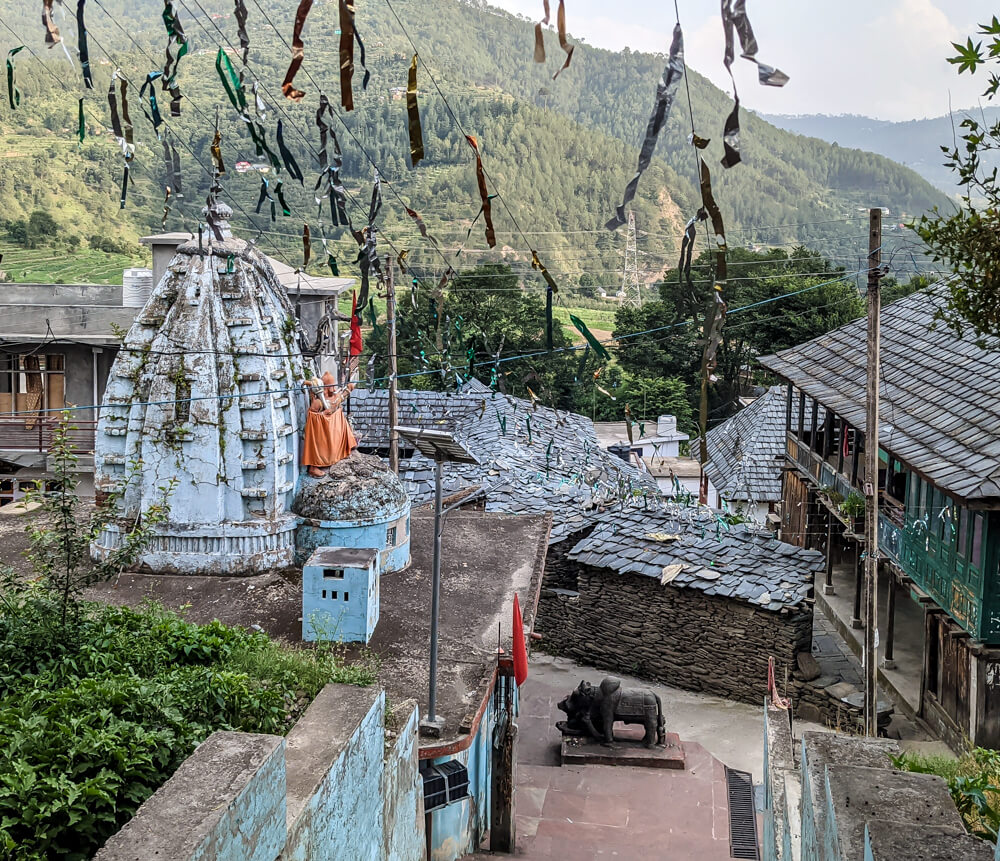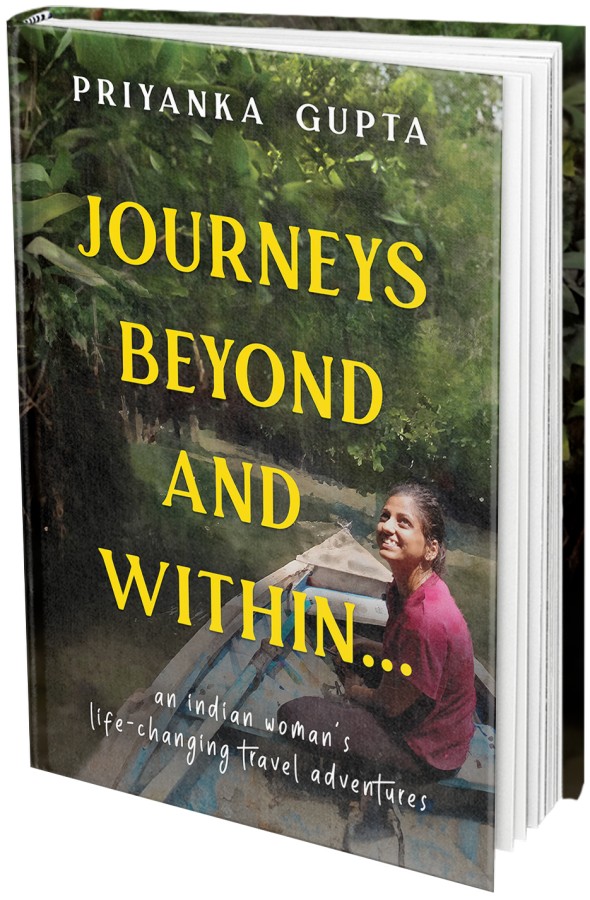So Much You Don’t Know About Pangna Village (Mandi, Himachal Pradesh)
Pangna village blew my mind. Before visiting this Mandi village in Himachal, I knew the rough history of Pangna.
I had read that the Suket dynasty had Pangna as its capital for a few hundred years. The Suket kingdom was of the Sen kings who were originally from Bengal. First, they moved from Bengal to Punjab. But when one of their rajahs was killed there, they fled to the hills. Here they made their first palace at Kunu Dar (near Karsog) in 778 AD. Then they shifted to Pangna and made the village their fort. Until 1240, the Sen’s ruled the Pangna area.
Somewhere there was a fleeting mention of the Suket King’s daughter who had committed suicide because the king trusted a Brahman’s words over her. And in her memory, the tall Kathkuni temple, more popularly known as the fort, was constructed.
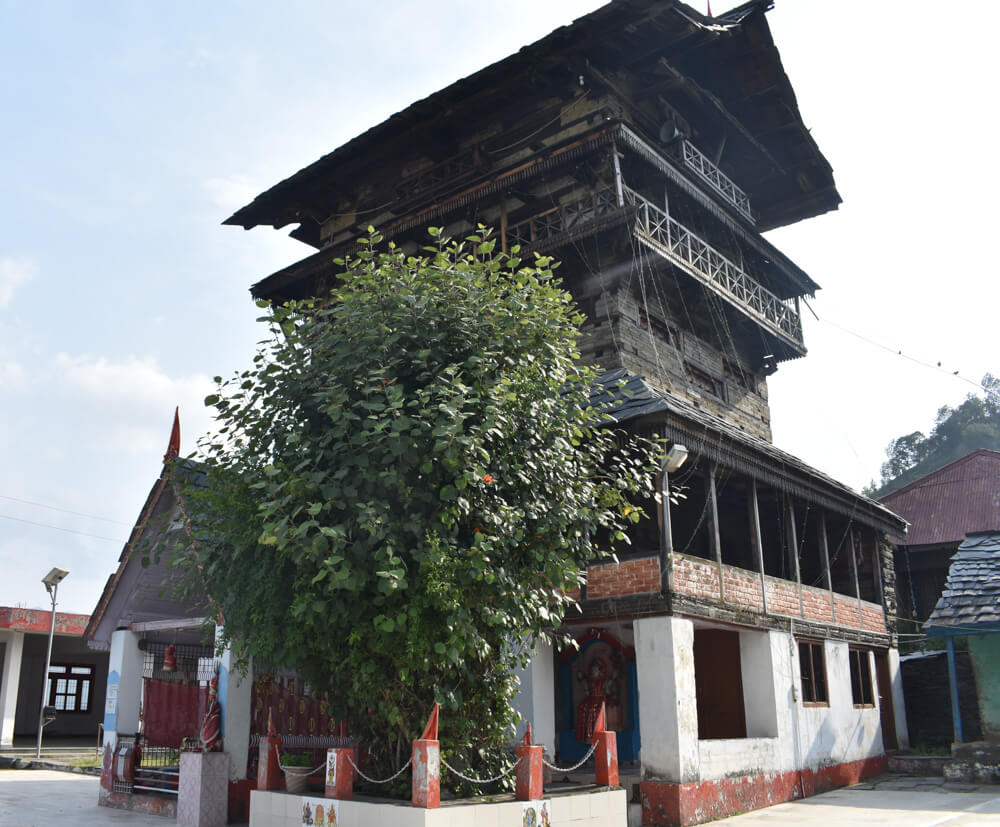
On the day we were moving from Gagal in Mashobra to Pangna, I had been urging my partner to leave early. My research told me the fort closed at 5 pm. How would we ever climb it if we arrive late? We rushed but the drive to Pangna from Gagal took us a few hours. Our journey was dotted with a quintessential stop to eat the peaches we had brought from the Gagal house, a stop at a roadside stall to munch on Maggie and have tea, and a short halt at another dhaba for some kadhi rice and a cup of chai. The beautiful views of the muddy Sutlej curling through the Tattapani valley below also made us stop many times.
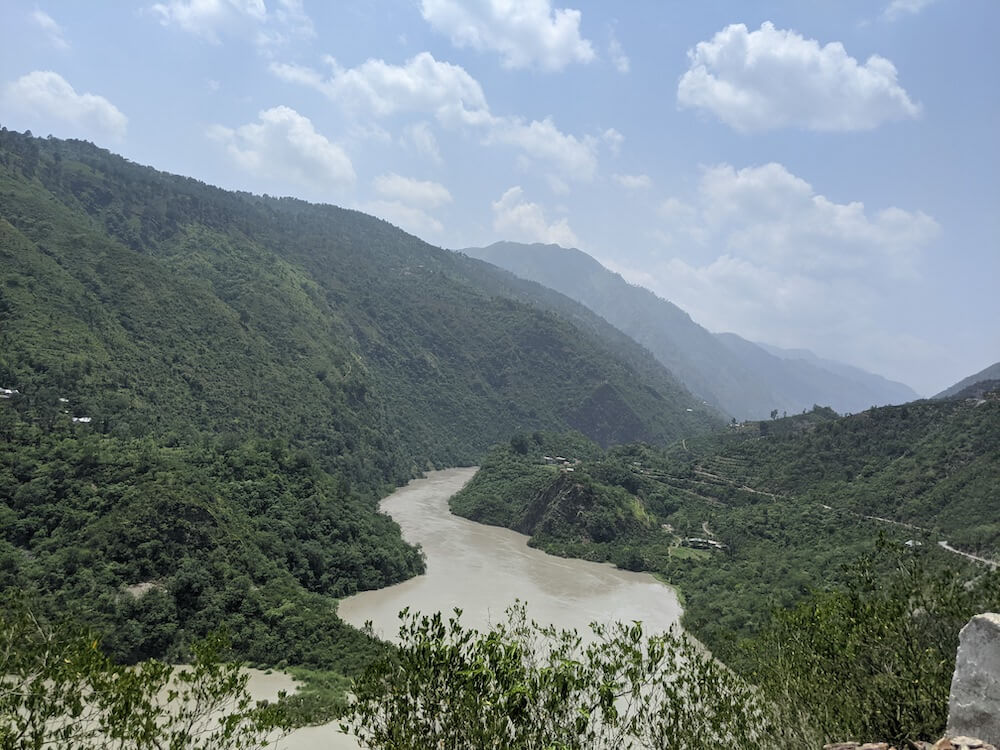
The drive further was on a single-lane road that curved around the slopes of a precipitous mountain. This is the Shimla Tattapani Mandi road which has been there for at least sixty years. The treacherous journey from Manali to Spiti Valley flashed in front of my eyes when we drove on that extremely narrow and mountain-edged roadway.
We couldn’t reach Pangna before four pm. By the time we arrived, the sun was hidden behind the clouds. I first checked into our PWD guest house. The grassy lawn of the guesthouse shone in the faded yellow light. And a tall Kathkuni building stood right behind the guesthouse.
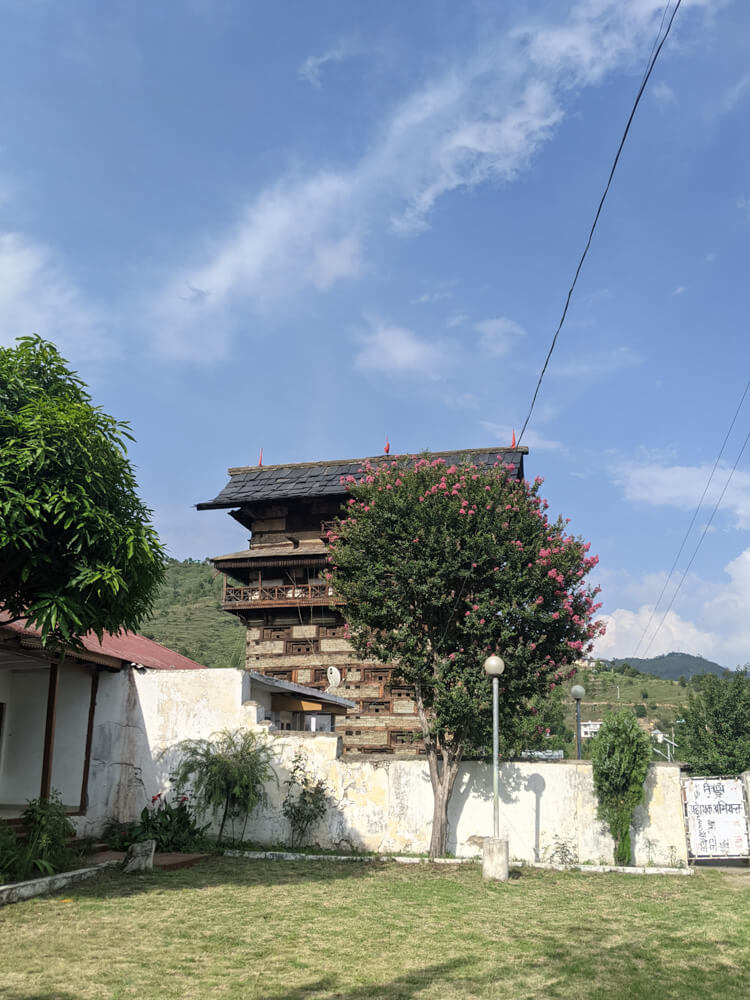
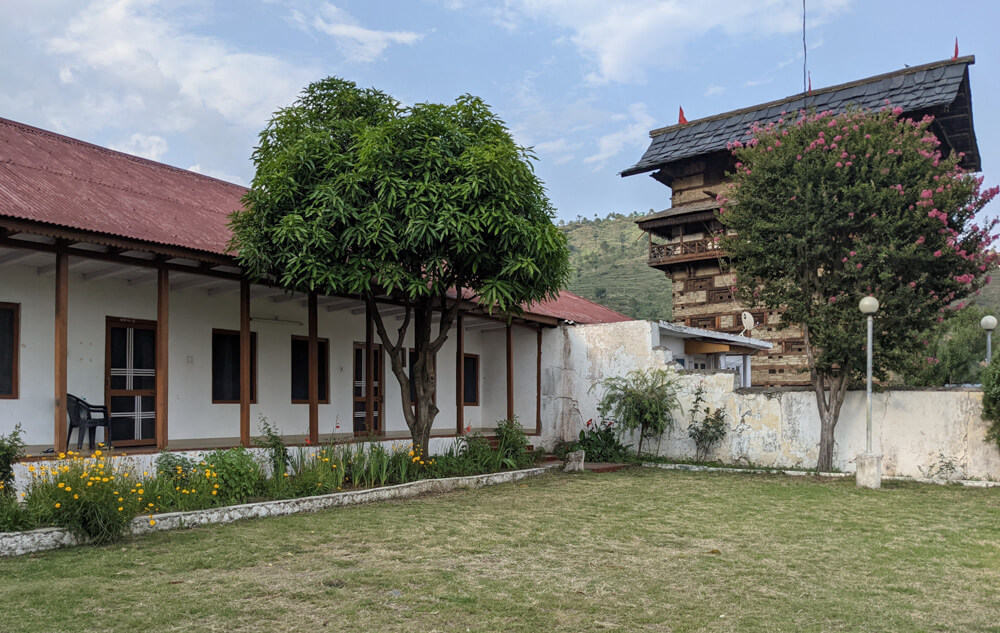
Could that be the fort? But doesn’t a fort has walls and one is supposed to climb it?
My confusion was soon cleared by the caretaker of the place.
“This is the Pangna fort, madam.” He pointed to the dilapidated brown wooden structure. “You can visit it from behind our guesthouse.”
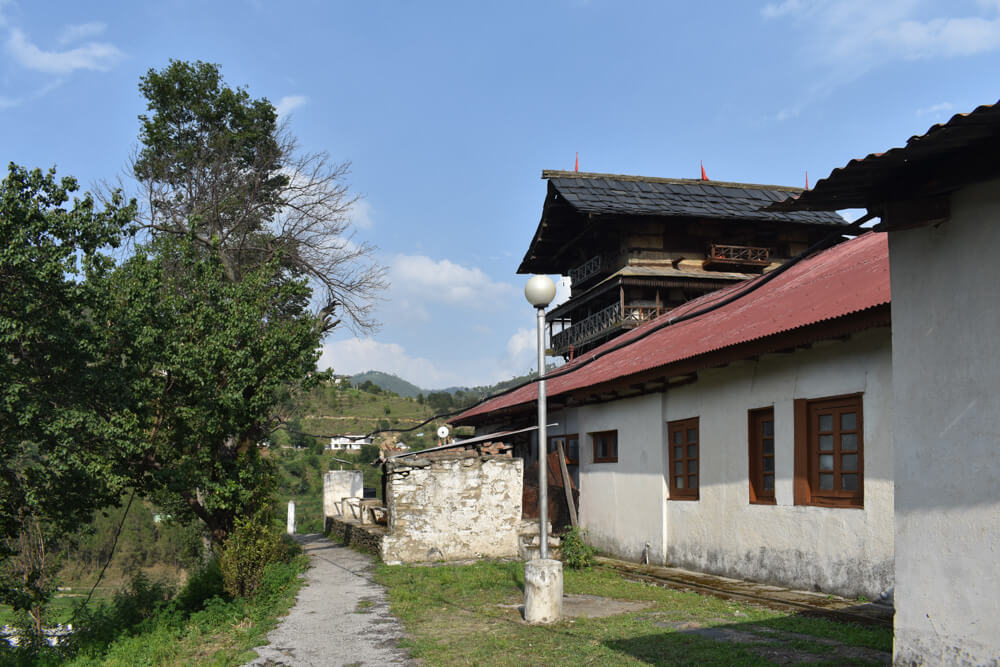
The caretaker took us to a narrow opening between the guesthouse and the government offices there. That pathway went through the backside of our rooms. Below we could see the Pangna village. One slated-roof hut stood right below this path. And slate steps curled downwards beside the hut.
“These steps go to the village market.” Caretaker jumped in to resolve my curiosity.
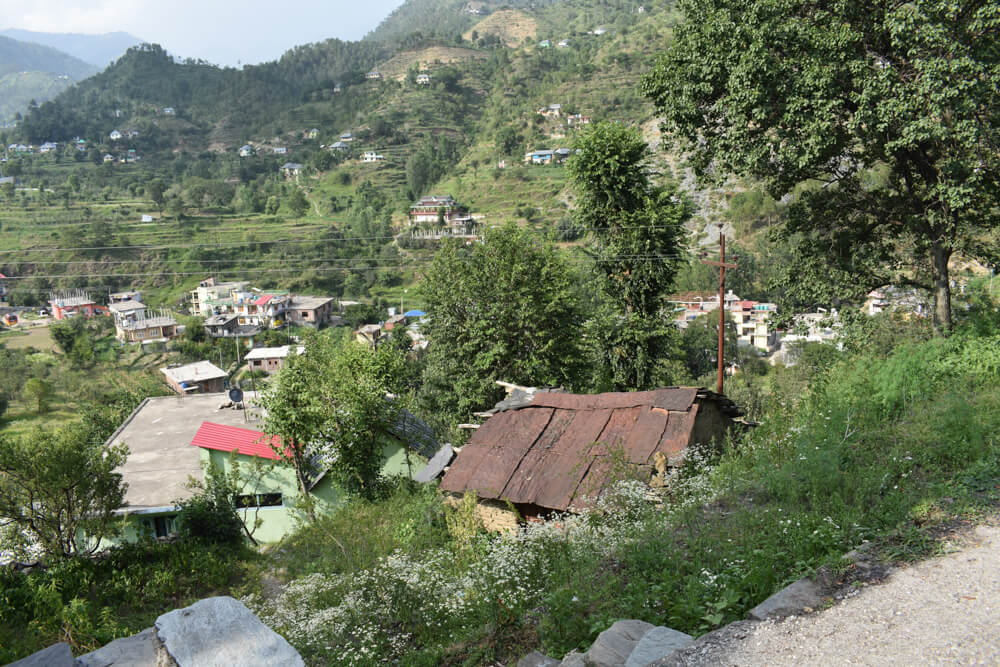
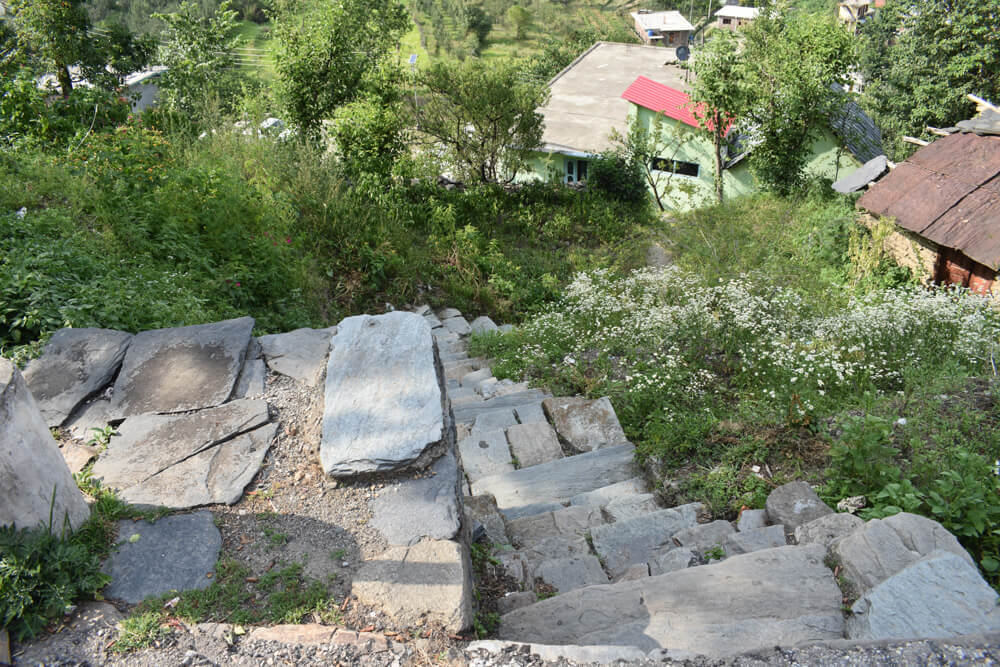
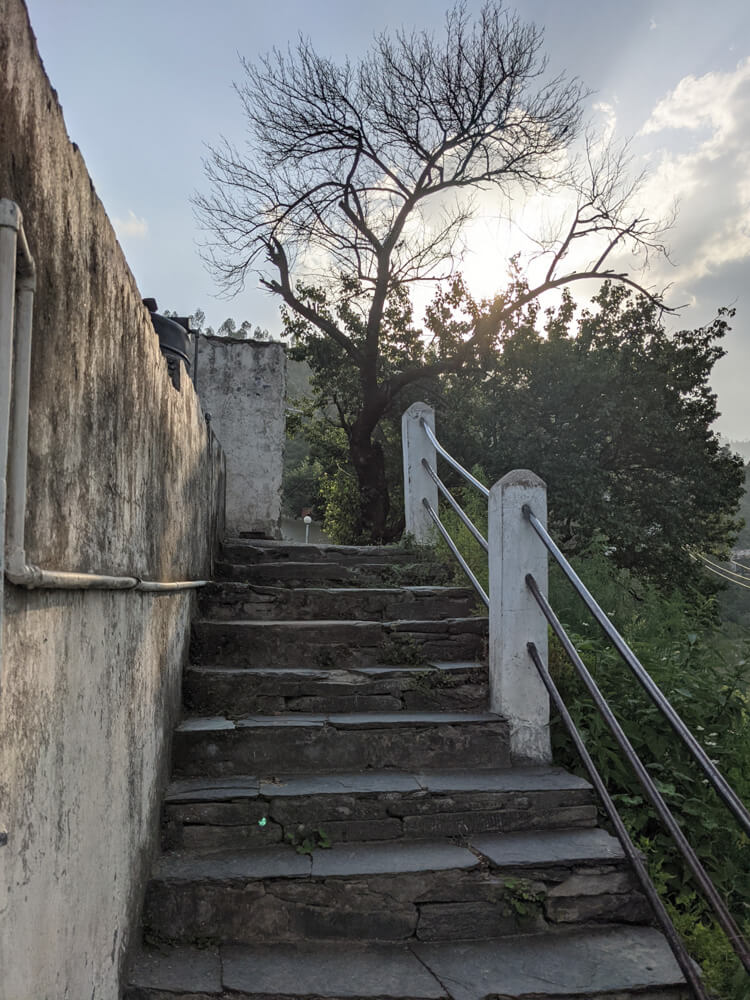
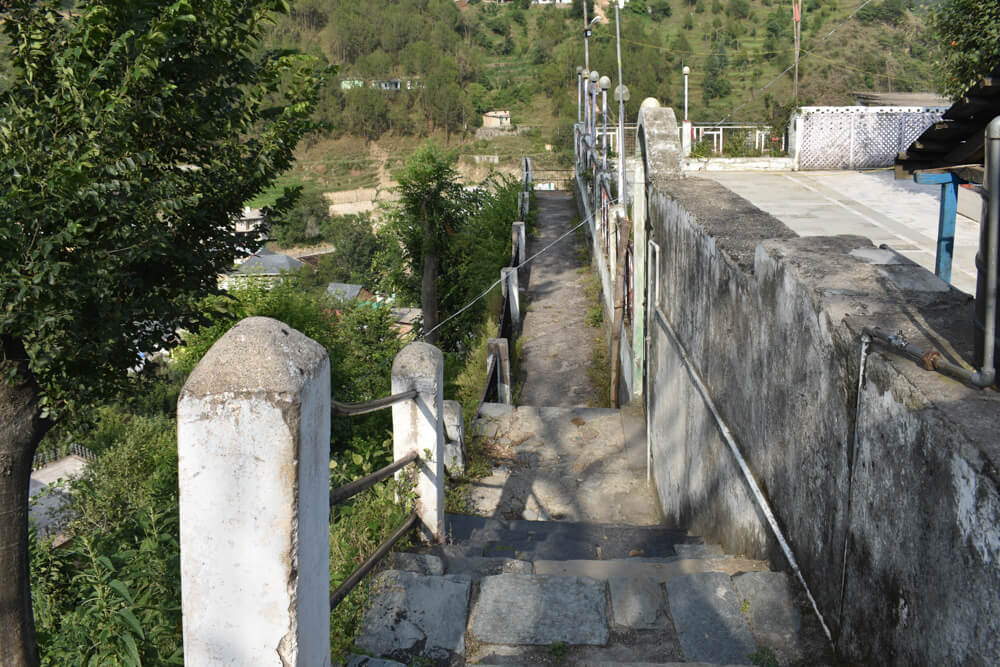
The cement path at the back of the guesthouse further went onto a few steps which descended into the Mahamaya temple, known as the fort. Once in the quiet temple premises, I felt I had gone back in time. The place was empty. Not even the priest was there. And we like it when we can explore on our own with no one to tell us where we can’t go and what we should see.
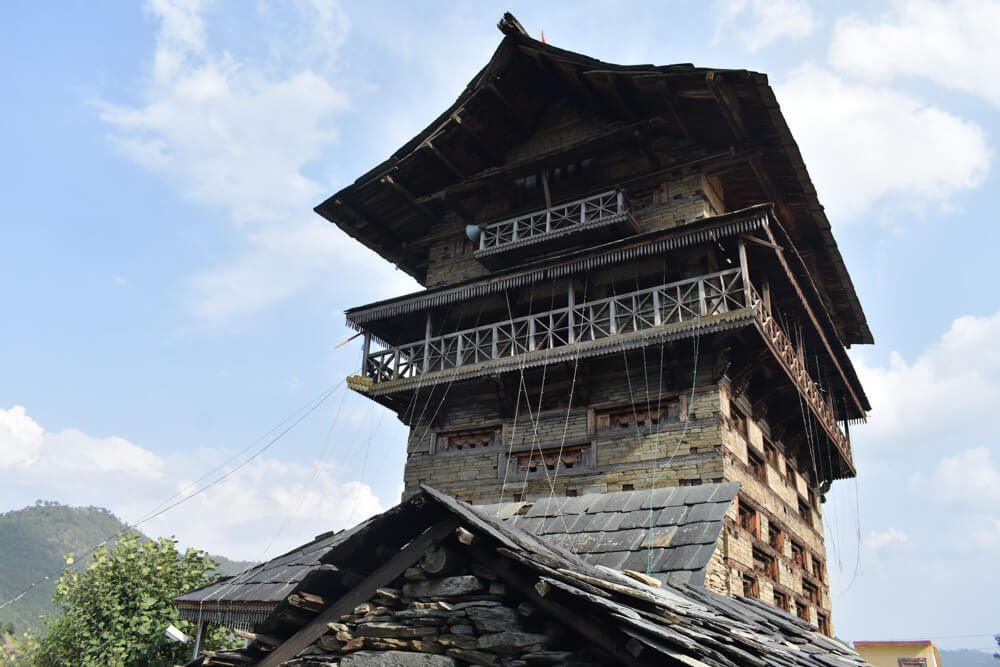

We admired the multi-story temple. The mandir is a fine example of the Kathkuni style of Himachal construction. Multiple layers of stone are balanced under a beam of wood and the pattern repeats in all Kathkuni structures. These stone-timber constructions are said to be highly resistant to storms and earthquakes.
Several other stone-roofed huts stood in the temple boundary that encircles the mandir. Some were shrines of other deities, and one or two huts must serve as the priest’s accommodation.
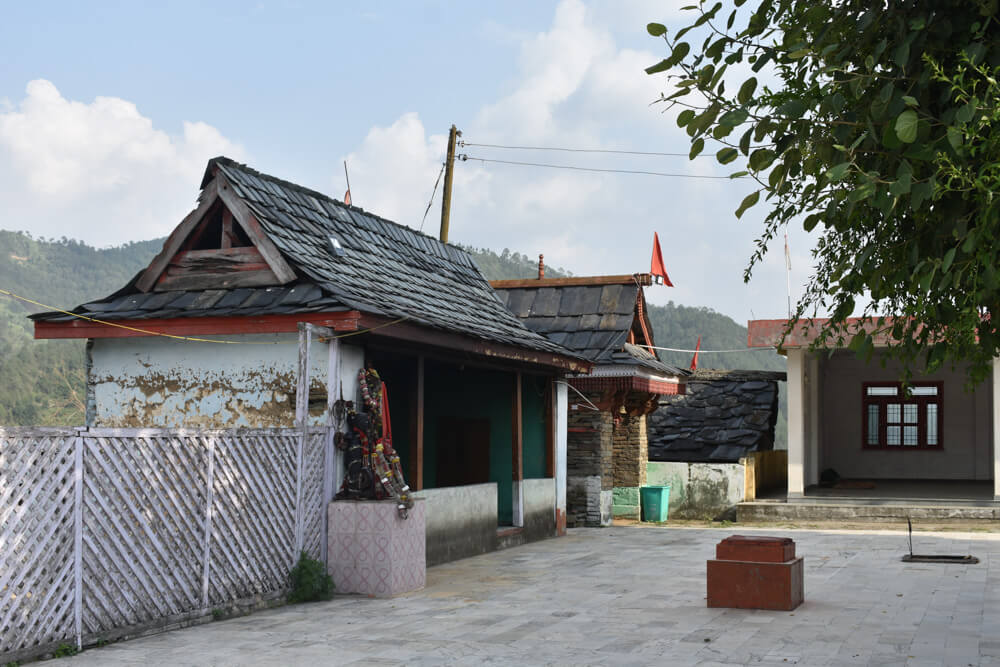
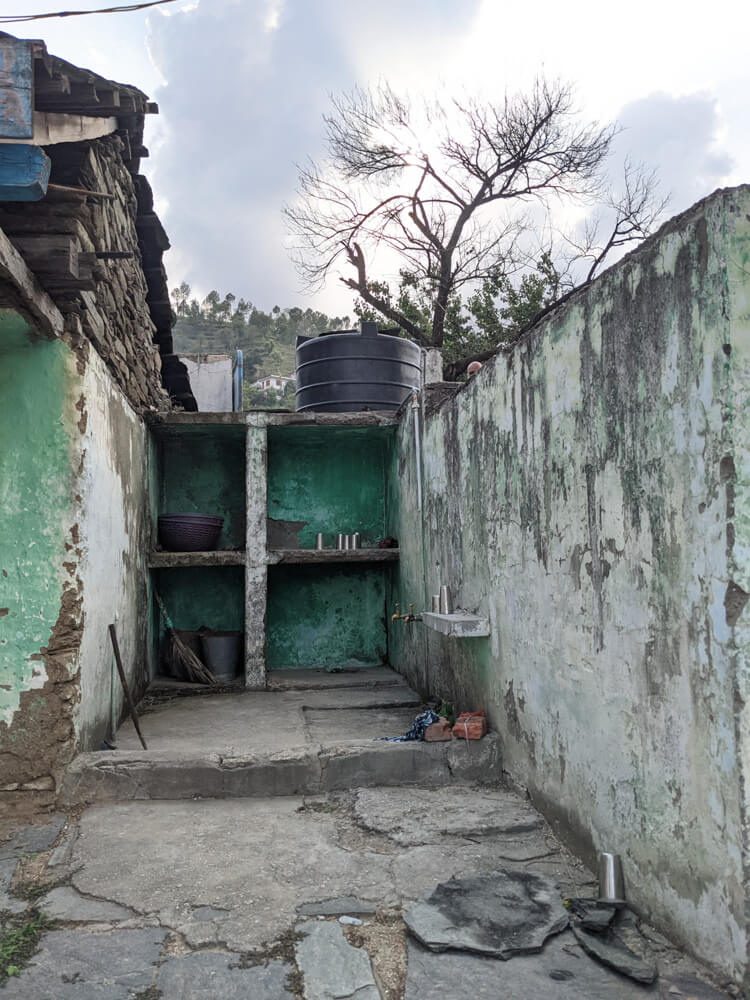
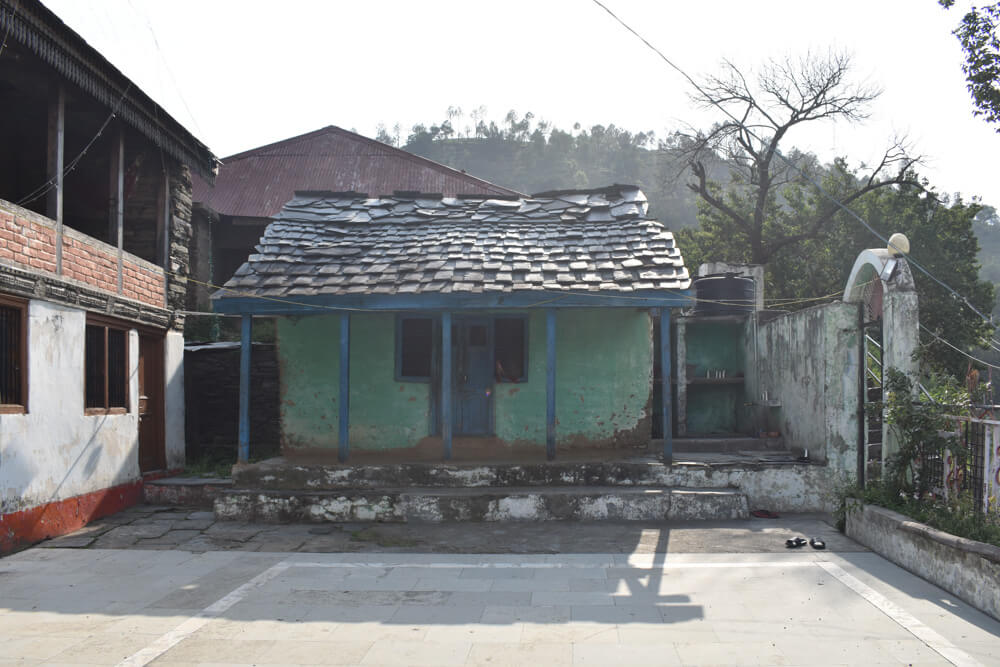
Under a tree near the temple, old stone relics and sculptures were kept. A grey cat slept next to the idols.
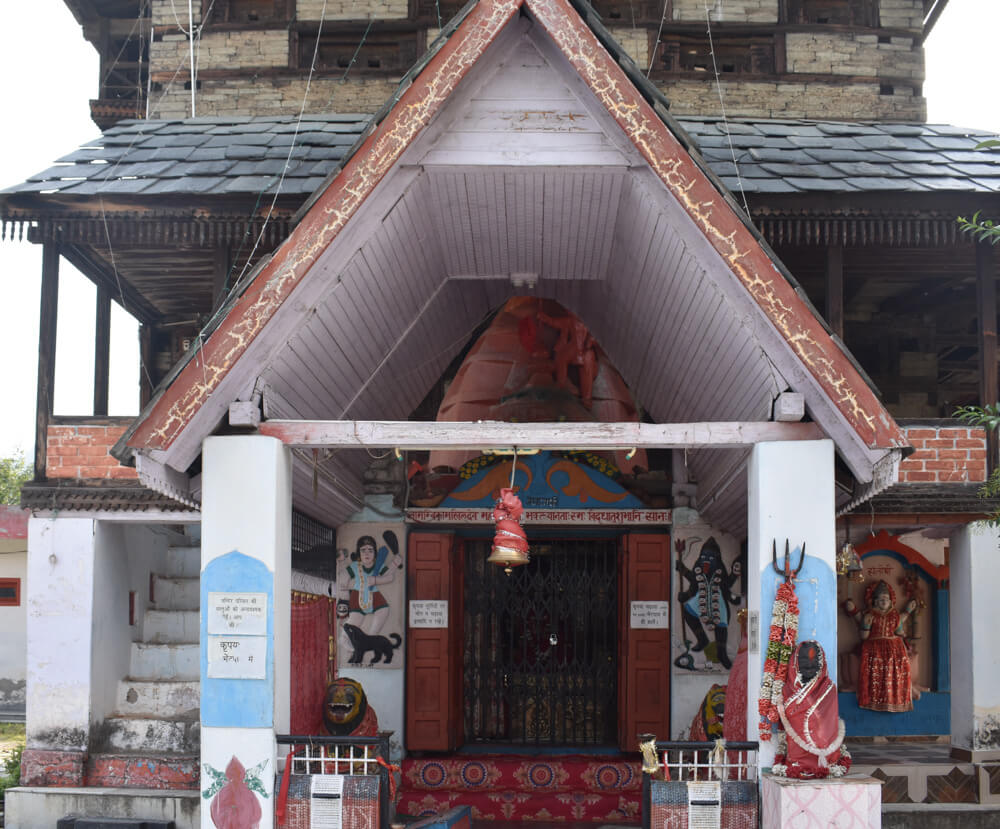
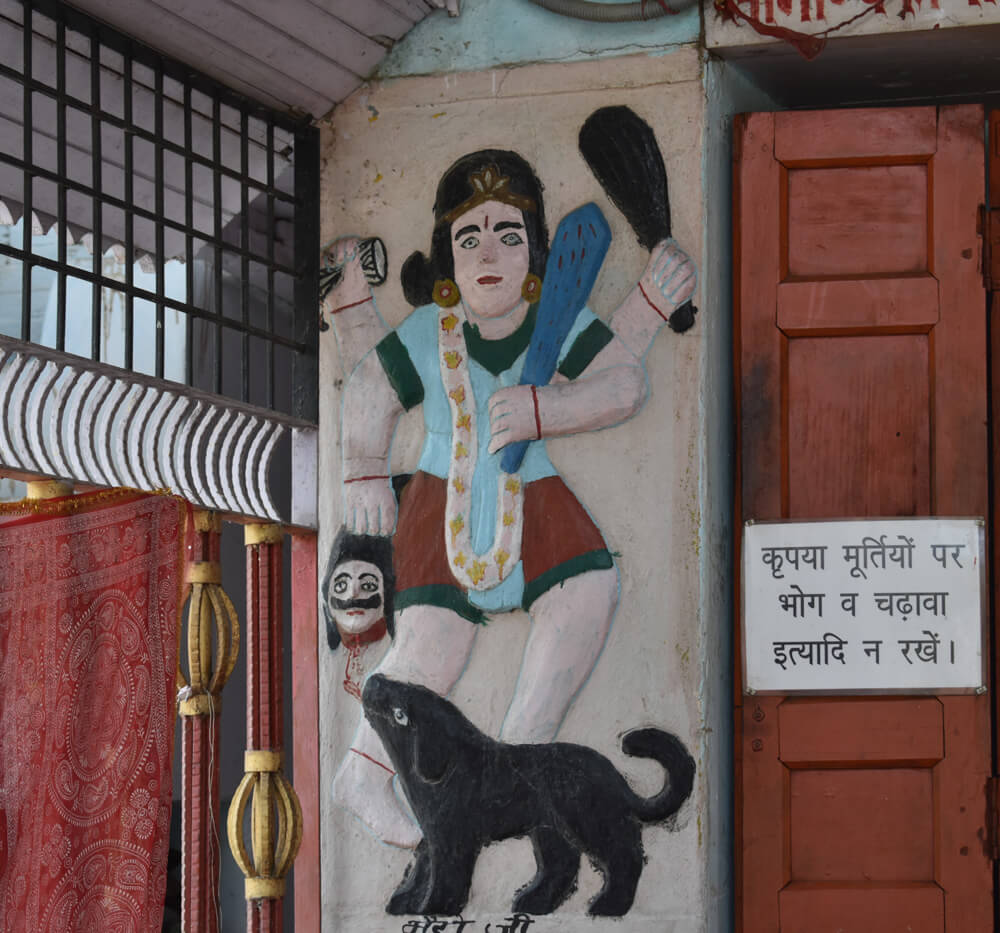
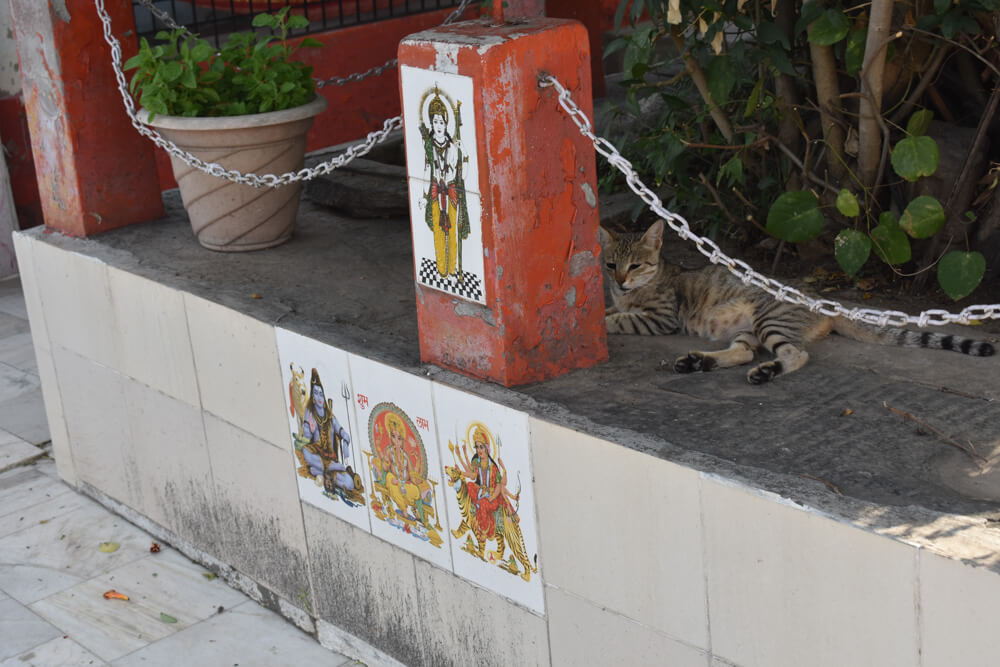
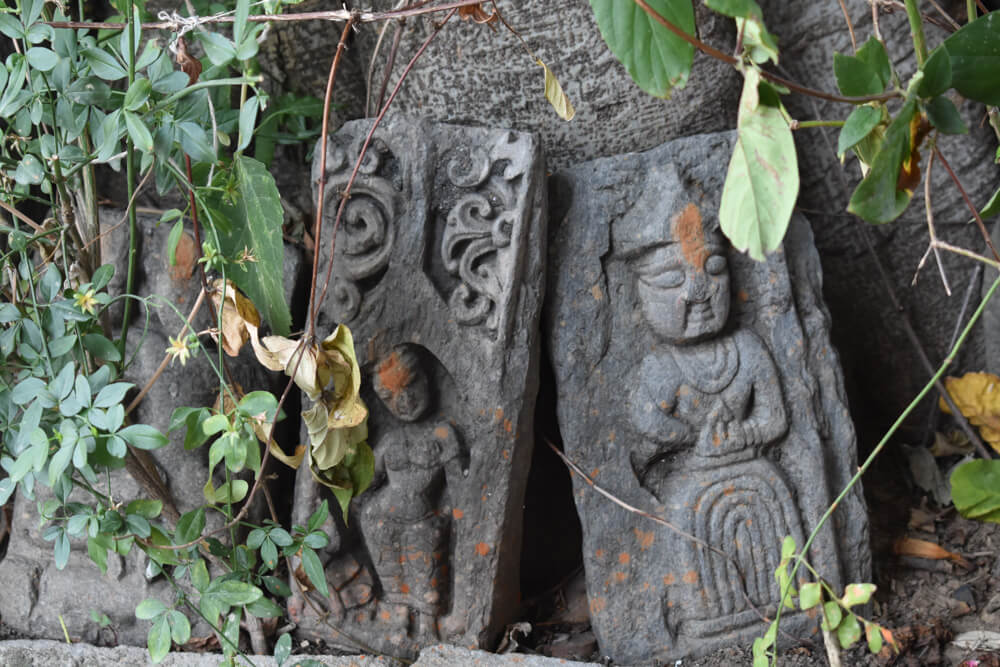
We observed the temple and the structures attached to it for a while. Once the fort was open to the public, but at present, no one can go inside it.
Now is a good time to disclose the priceless Pangna resource I discovered on the internet. I found a village survey of Pangna done by the Census of India in 1961 (the link will take you to the survey). In that year, the census had decided to study the social and economic developments of a set of disparate villages in India. Pangna was one of those chosen settlements.
I have to tell many things from that 92-page report, but first, I would like to iterate the legend of the Mahamaya temple as recorded in the file.
The legend relates to the daughter of Raja Bikram Sen. The actual event is said to have taken place some eight hundred years ago. One evening, Raja’s younger daughter was playing with her friends. Some of them had dressed up as boys for the game.
A neighboring Brahman suspected and reported to the Raja that his daughter had affairs with some boys. She was rebuked and scolded to such an extent that she committed suicide by taking powdered Diamond. She left a letter saying that for the proof of her virginity and piety, her corpse might be buried under a particular rock. And that if after six months the grave was again dug up, the corpse would come out un-decayed. (Girls in one of the Mandi district villages told stories about how they weren’t allowed to play around because their parents were worried they would meet boys.)
The Raja did accordingly and after six months, he found the corpse of the princess just as it was buried, un-decomposed. The Brahman who was responsible for the tragedy was declared ‘Chandal’- untouchable. His descendants are still treated as untouchables. The Mahamaya temple is said to be made the king in the memory of her deceased daughter.
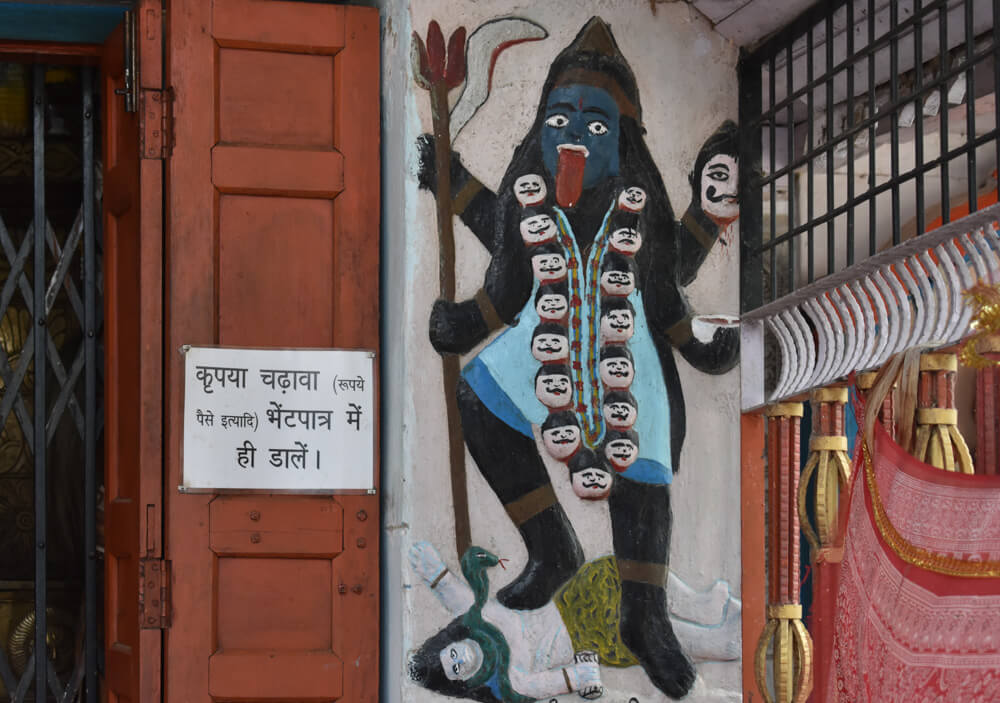
The census survey talks in detail about the Pangna villagers following the caste system strictly (that was around 1961). I’m not sure if the cobblers are still considered untouchable or Harijans enjoy all the pleasure. But my homestay Aunty here in Mandi tells me cobblers are still called chamars. And that Harijans belong to a high caste.
Thinking of the history of the Mahamaya temple, we went out of a door from its courtyard. Down a few steps, we came to another entrance to the temple. In front of this entrance, lay the open land of the temple which had now turned into a shrubbery. There we stood watching the Pangna village sprawled ahead.
In that afternoon hour, the village and its surrounding looked very dusty and hot. The roads below in the village were kaccha and thus muddy. Huts were divided between the sloped rooftops covered with the local Himachal stone and flat-roofed constructions (probably new). Apple orchards were scattered between the huts.
Far ahead, the mountains on the other side had sparsely distributed houses and terraced farmlands. All the surrounding hills looked similar to our outsider’s eyes.
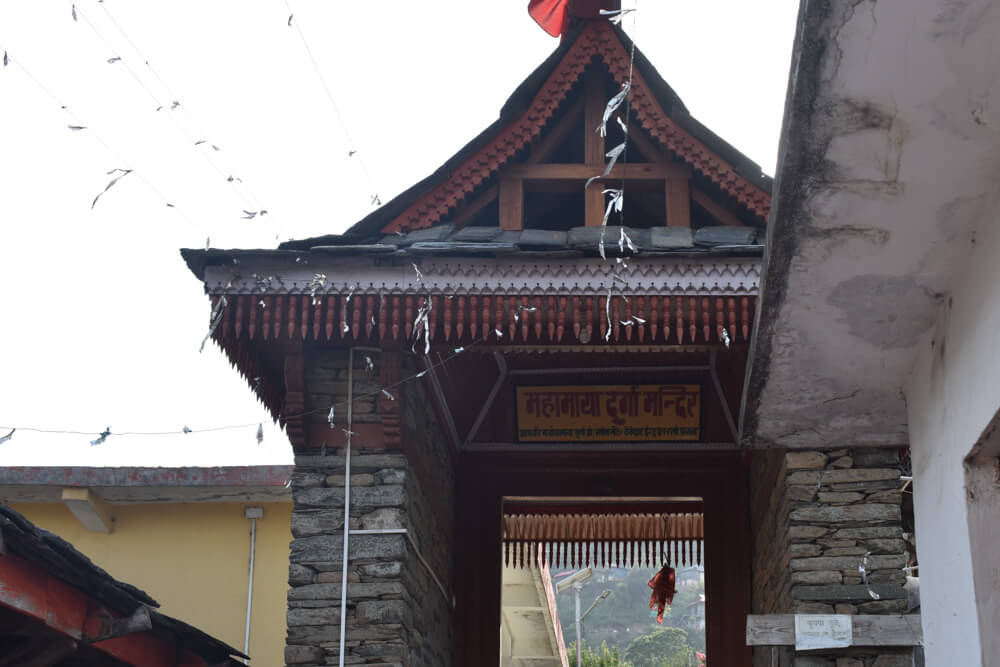
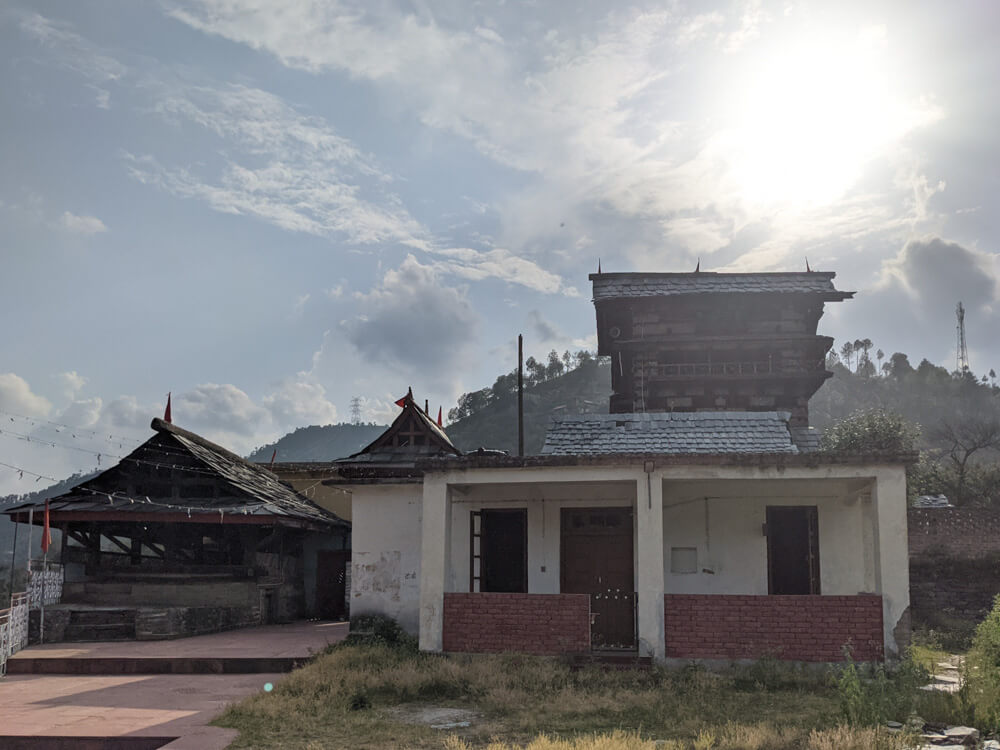
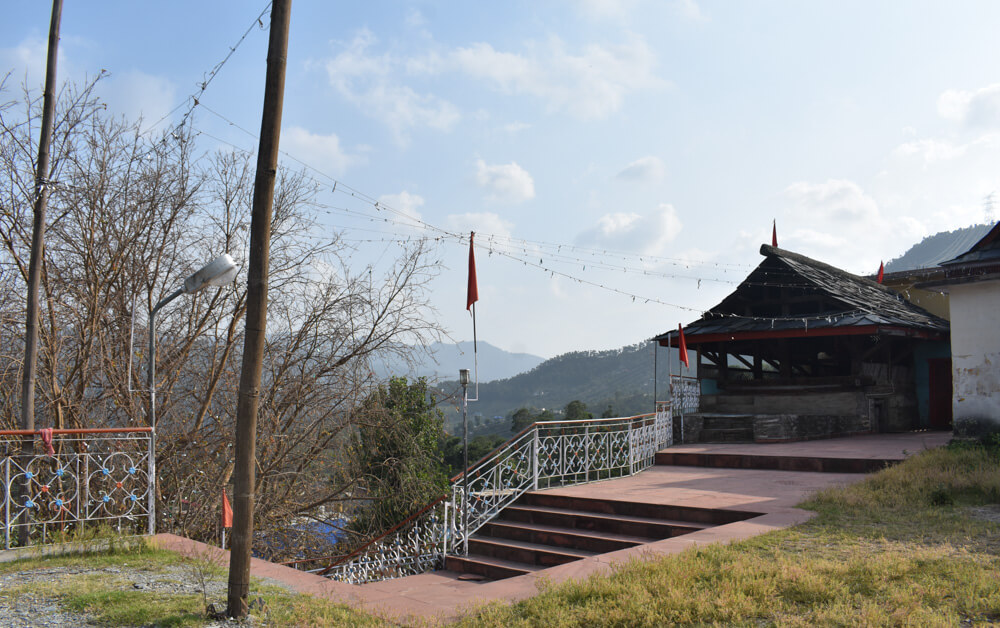
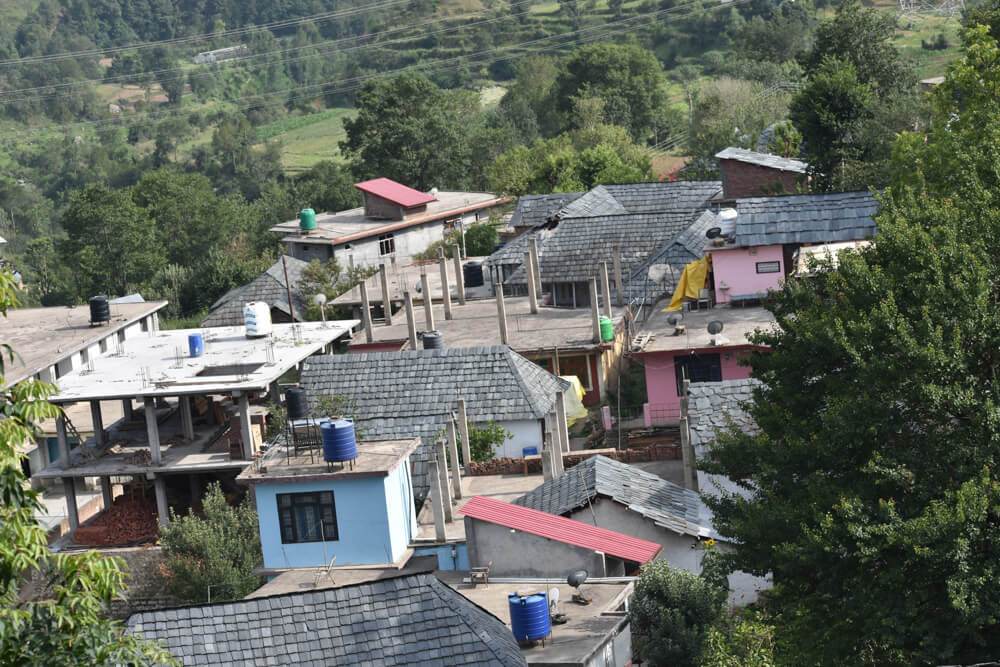
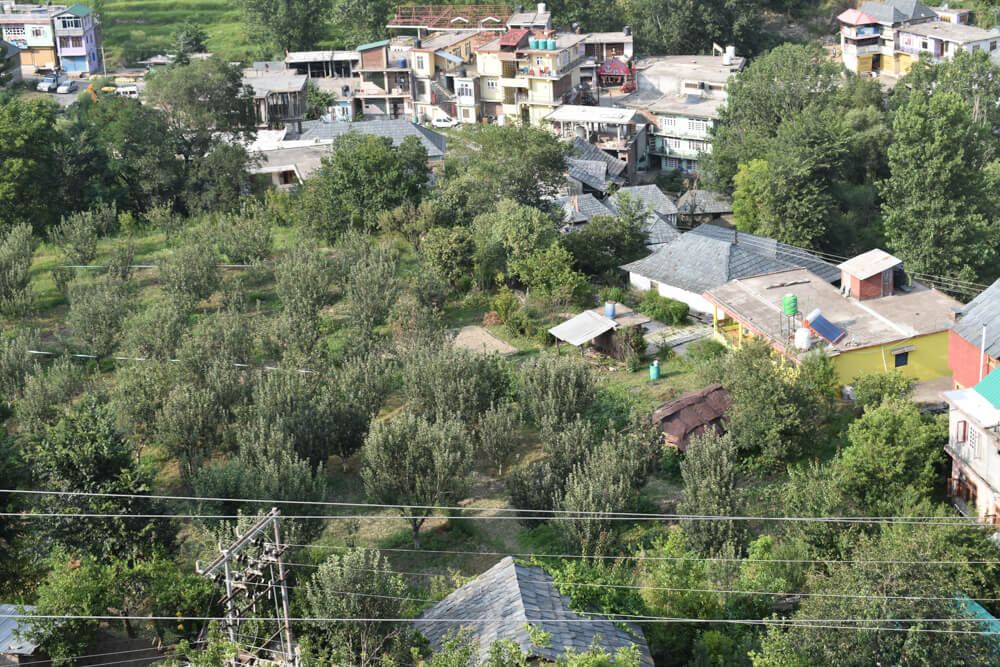
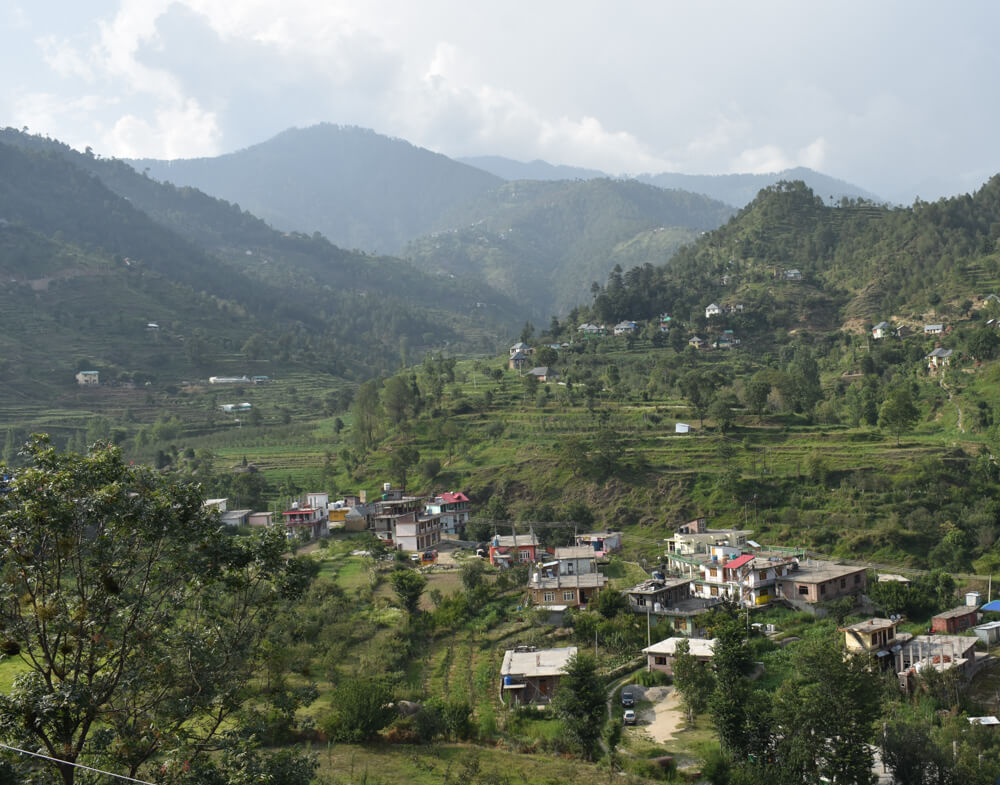
We were told to visit the Shikari Mata temple from there. Given the weather was almost clear those days, we could have spotted the hilltop open mandir of Shikari Devi. But we didn’t know about the temple’s importance and didn’t pay it any attention. We later did a very interesting hike to the temple. I have written about our adventure to Shikari Mata Temple of Mandi in the linked guide.
From this Durga temple, a long series of steps went down. A large pipal tree shadowed the stairs. And at the end of the staircase, another blue temple with a snake on its roof and Nandi bull outside was located. We climbed down a few steps and sat under the pipal tree.
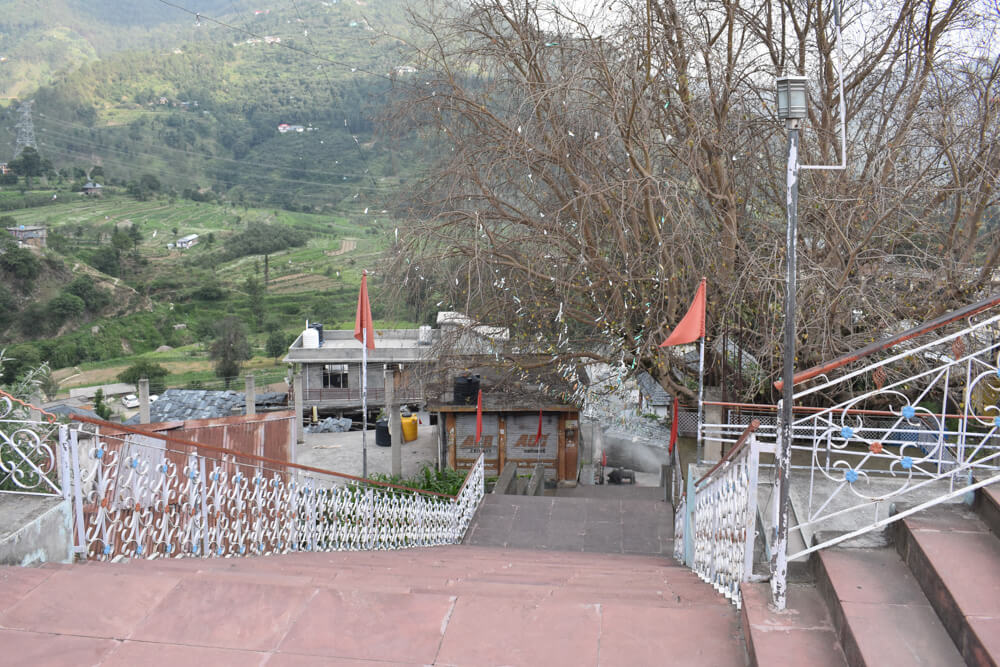
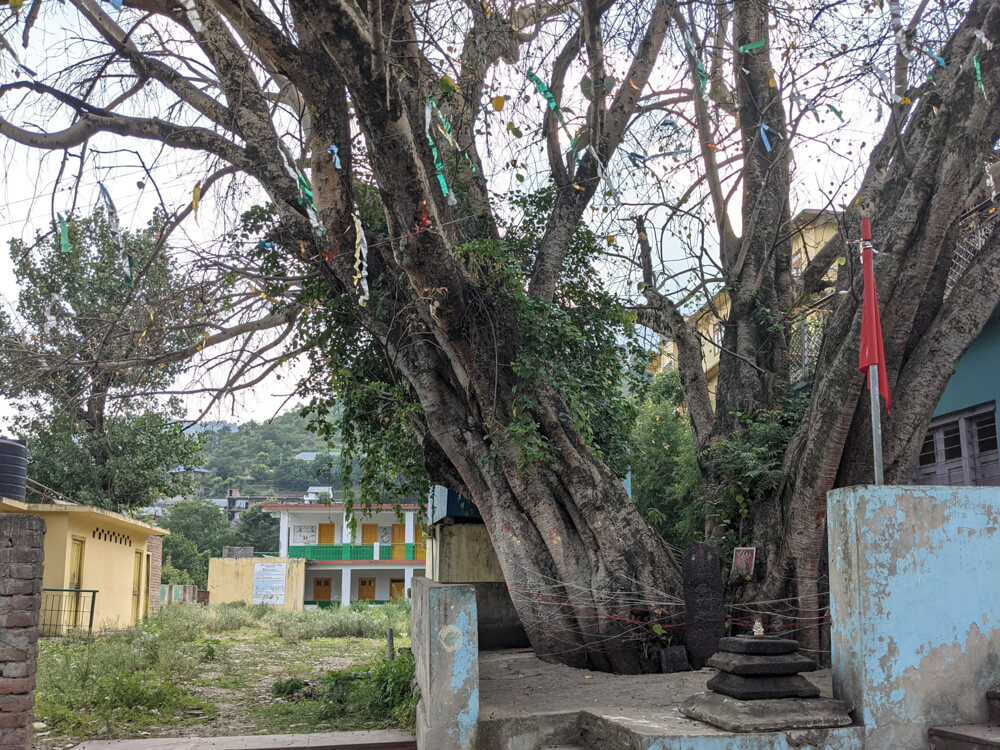
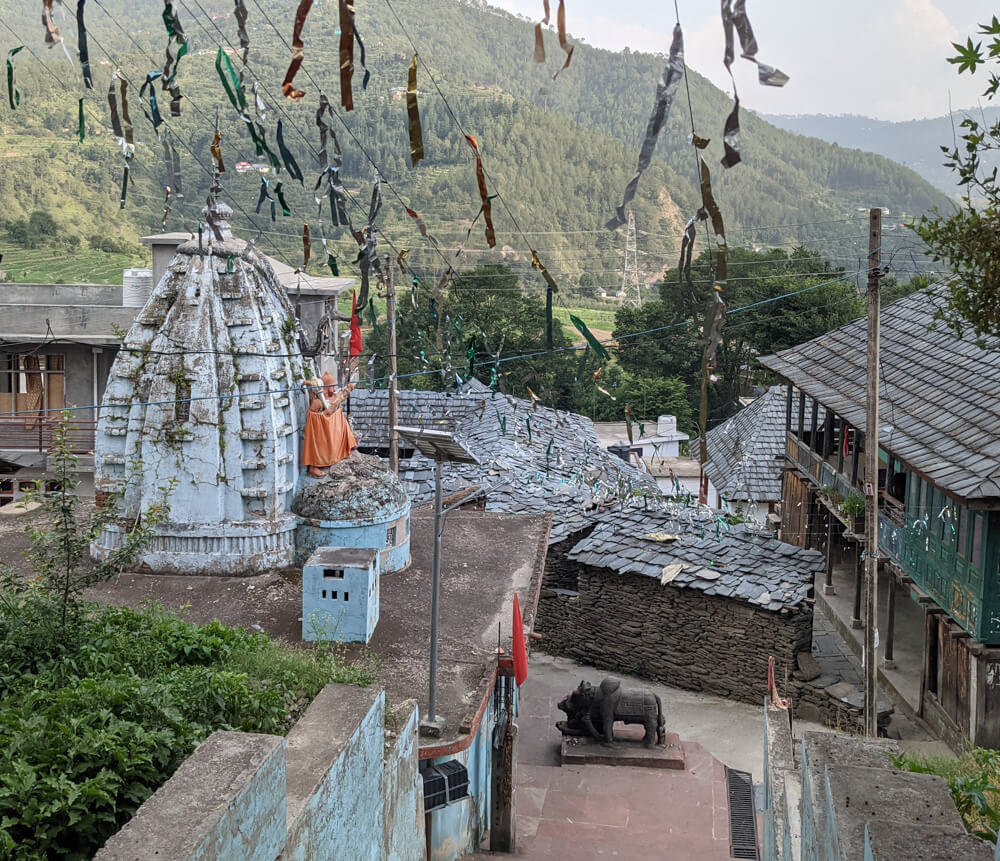
The giant tree had shed almost all its leaves except some golden flaky ones that fell with the slightest gust of wind. The tree’s trunk was bifurcated into two and each division was the girth of an elephant. Several ancient relics were kept under this pipal tree too.
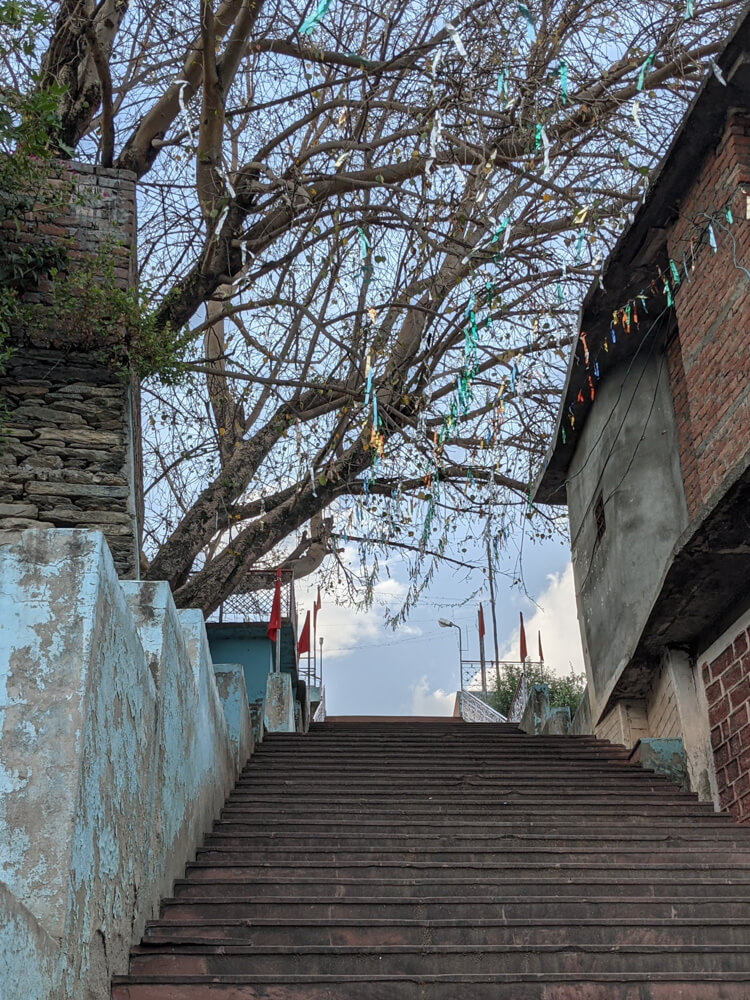
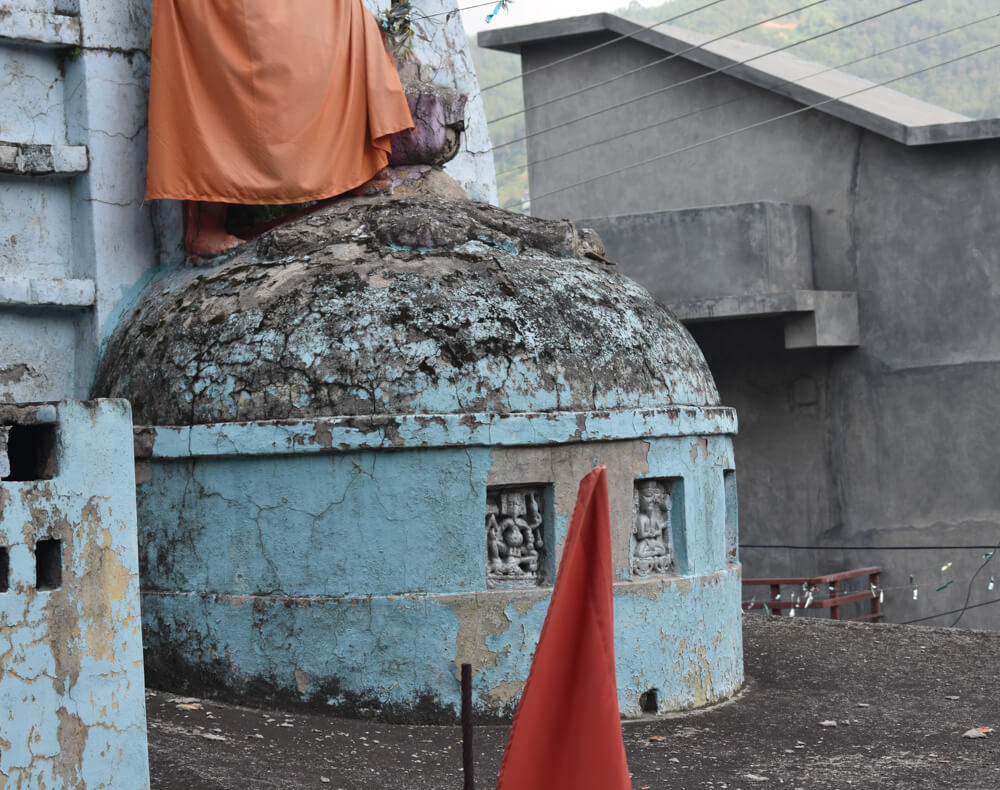
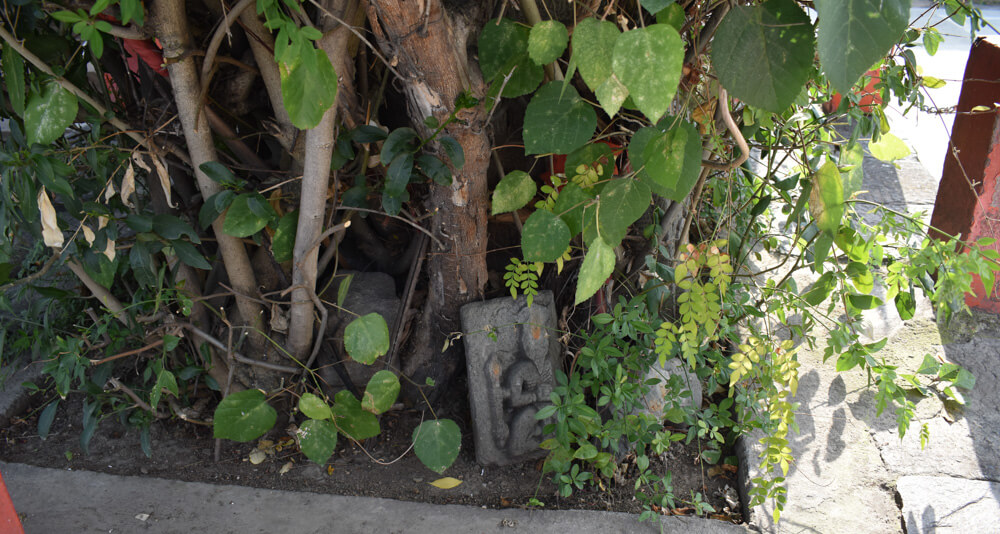
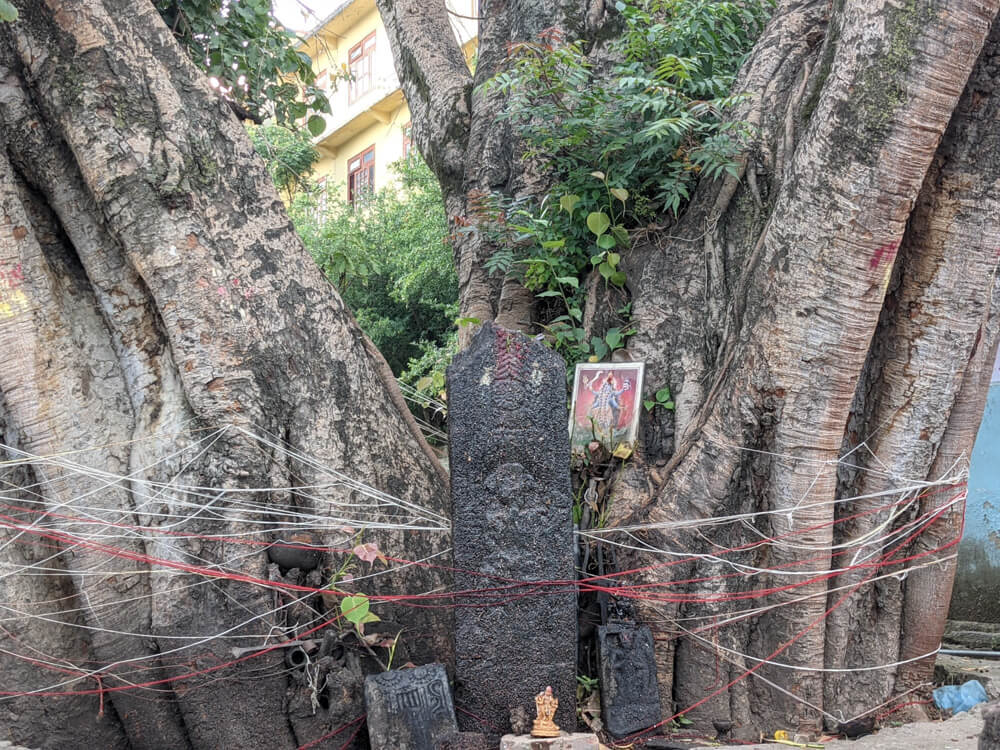
The engravings on the temple ahead told it could be hundreds of years old. A Shiva painting adorned the patched walls of the mandir.
The census survey explicitly said the hill people are mostly the worshippers of Shiva, and the Shiva temple of the village occupies the most important position among other temples.
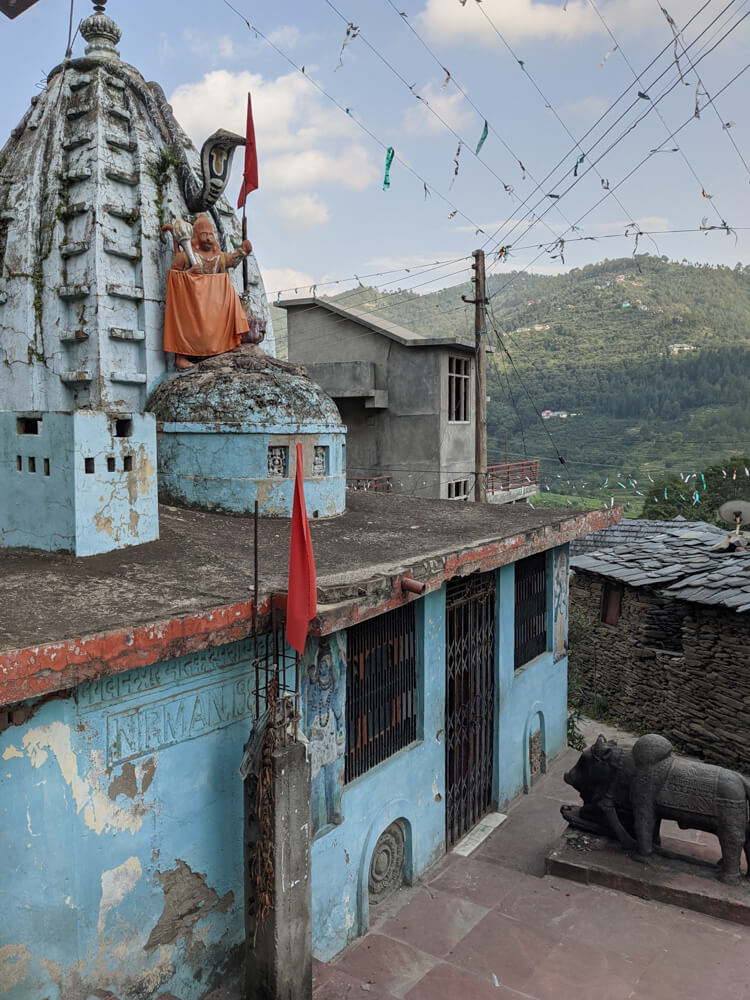
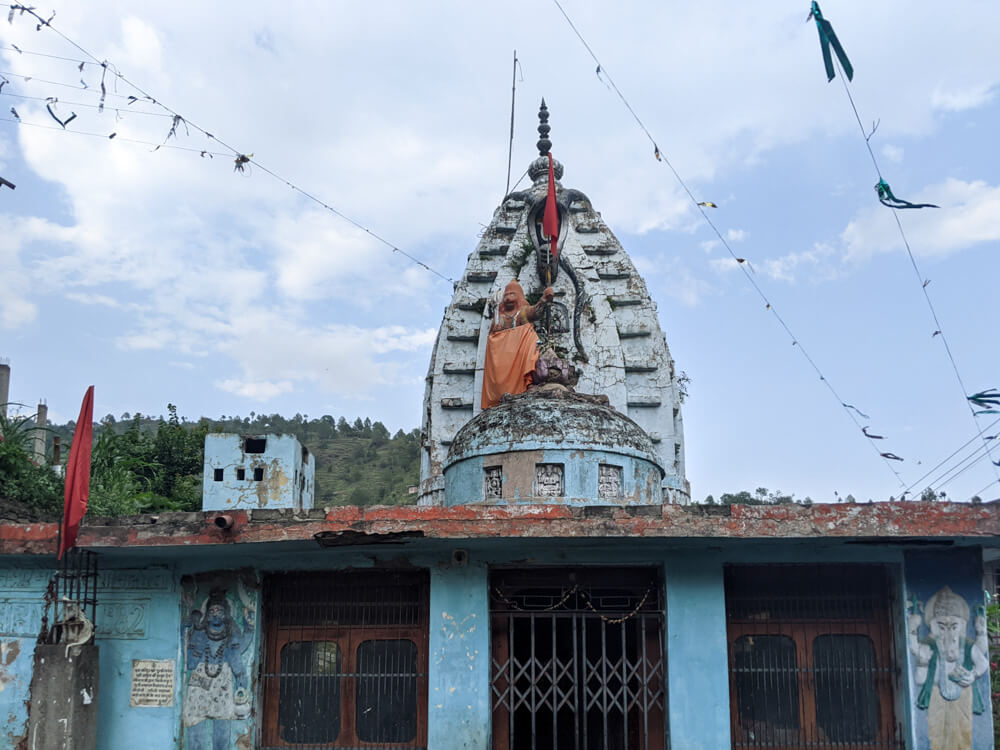
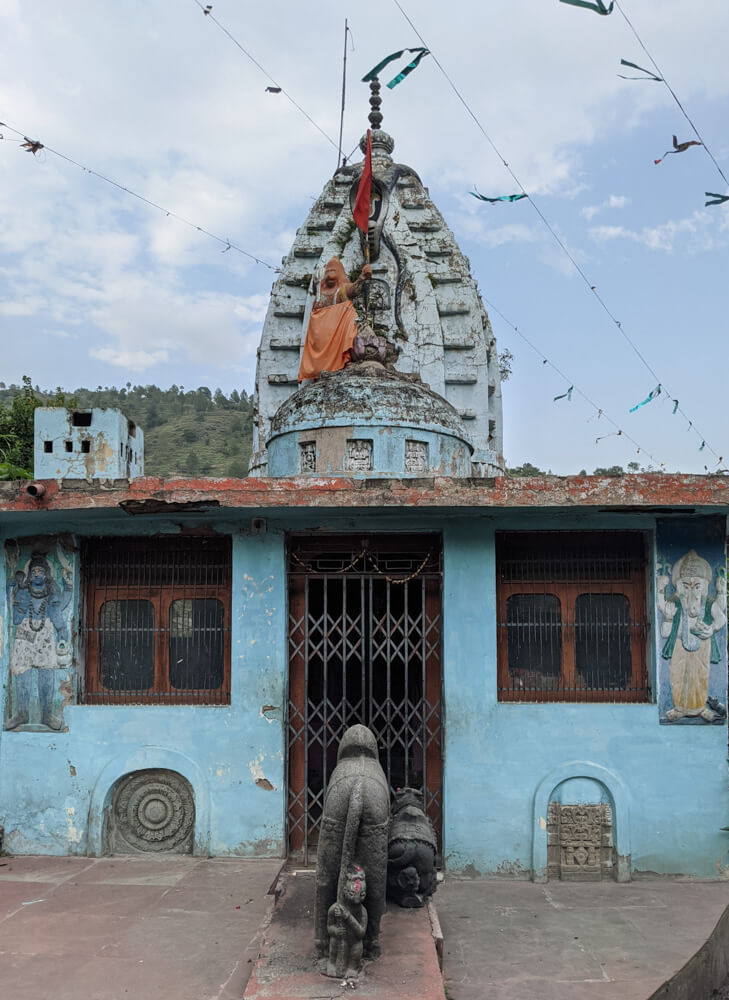
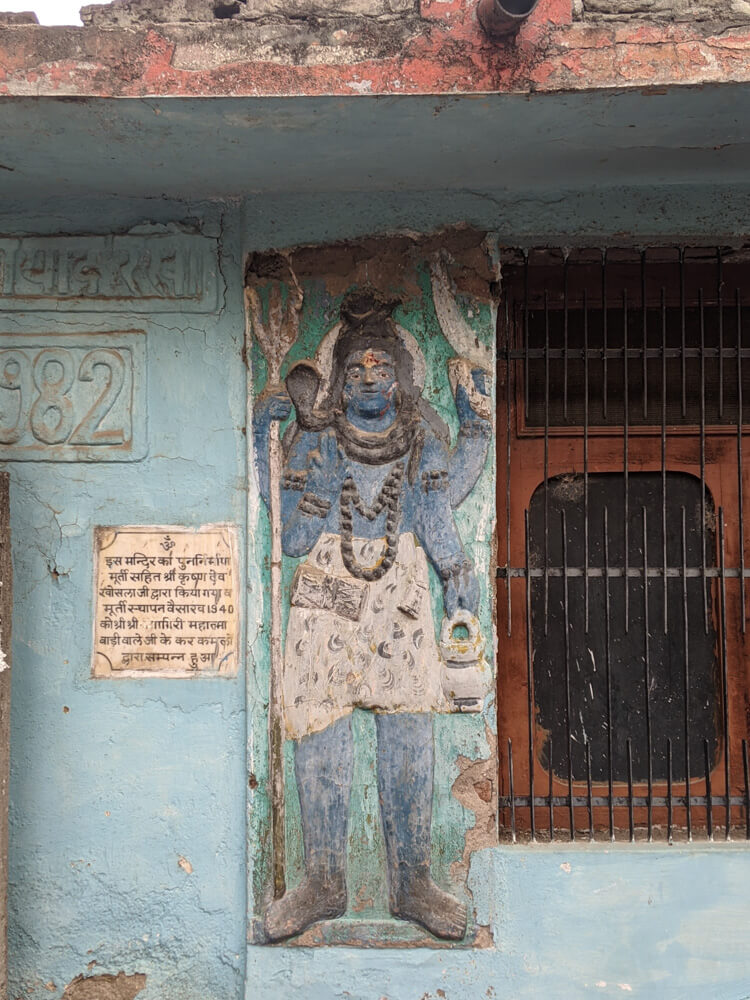
This temple was reported to be more than a hundred years old (in 1961). So now we were admiring, at least, a 160-years-old structure. It was built through the contributions raised by the business community of Pangna.
The images of Ganesh and Shiva were on the walls of a small cabin, some five feet square in which ‘is housed the Shivling. In front of one of the entrances (out of the two) a carved statue of Lord Shiva’s Nandi bull stood. A child clung to the tail of the Nandi.
The survey noted that the outside walls of the temple were made of timber and the roof was made of slates and supported a brass Kalash on the top. I think the structure has changed significantly over the years. Now instead of a Brass Kalash stands a statue of Hanuman and a snake’s head on the roof and the walls of the temple are now of bricks and cement.
As per the survey, a local Brahman was appointed to perform puja in the temple when it was built. Some 150 bighas of land were donated to the temple by various donors and the produce of the land was fixed as the wages of the priest for his service to the temple. In the course of time, the Brahman’s family grew up and then there were as many as twelve shareholders of the land and other income from the temple. The puja was performed in turns of one month, by every one of the shareholders. As for the land it has already been divided among the twelve shareholders, every one of whom tills her portion.
You can read the entire story of the temple in the report. But one thing that should be noted is that during Shivratri, pooja is conducted in the temple and devotees stay up keeping a fast all night.
In the quietness of the temple, we heard chatter around us. Old-style wooden and stone huts stood in the street right opposite the temple. Ladies sitting near the rooftop of one such house were observing us closely, and I heard the motion of a camera (probably the one in my hand). A teenage boy came out of the house and shut the wooden plank behind him. He peeked at us and went down the street. The stone huts studded between temples and surrounded by fields and orchards looked tempting to be explored. But given the coronavirus pandemic, villagers have been wary of tourists. So we maintain our distance and do not intervene much.
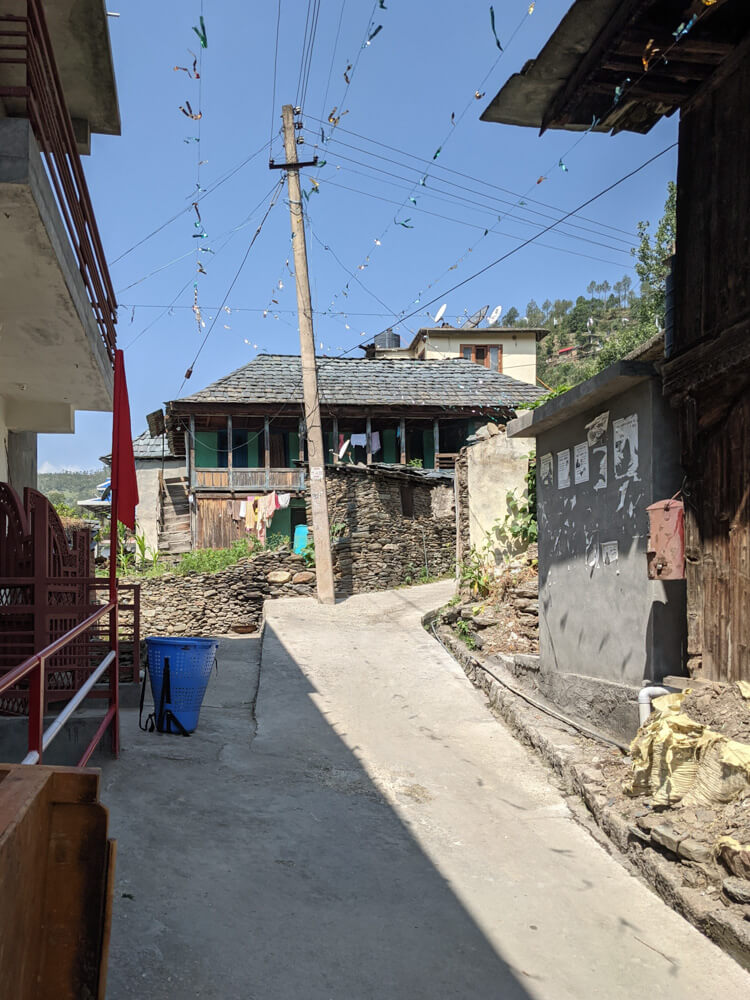
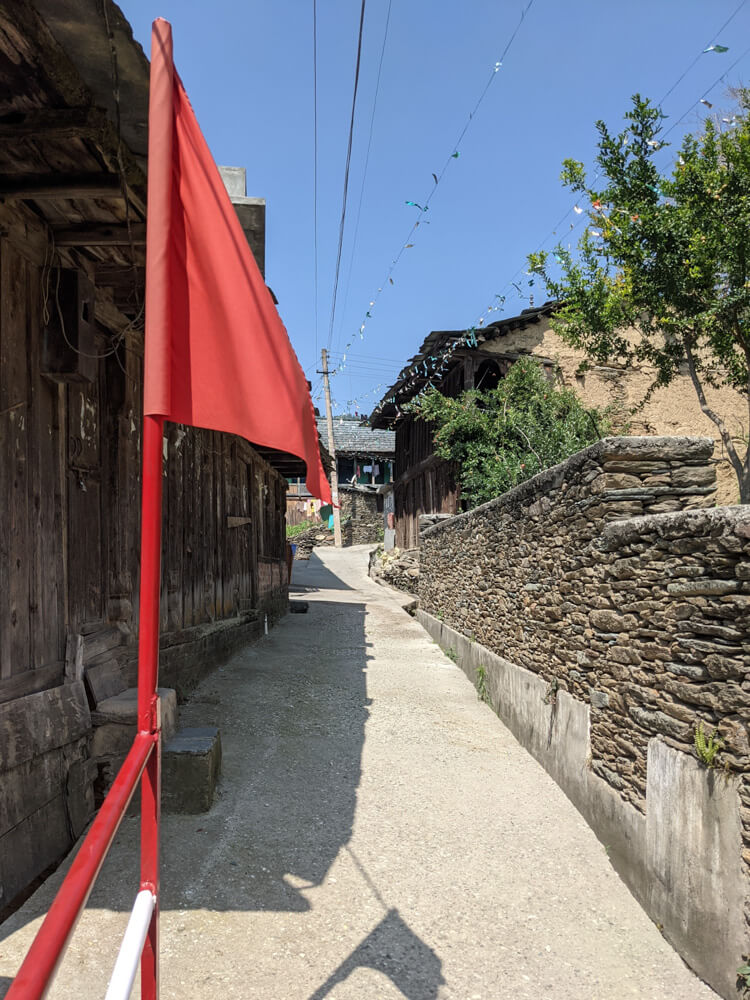
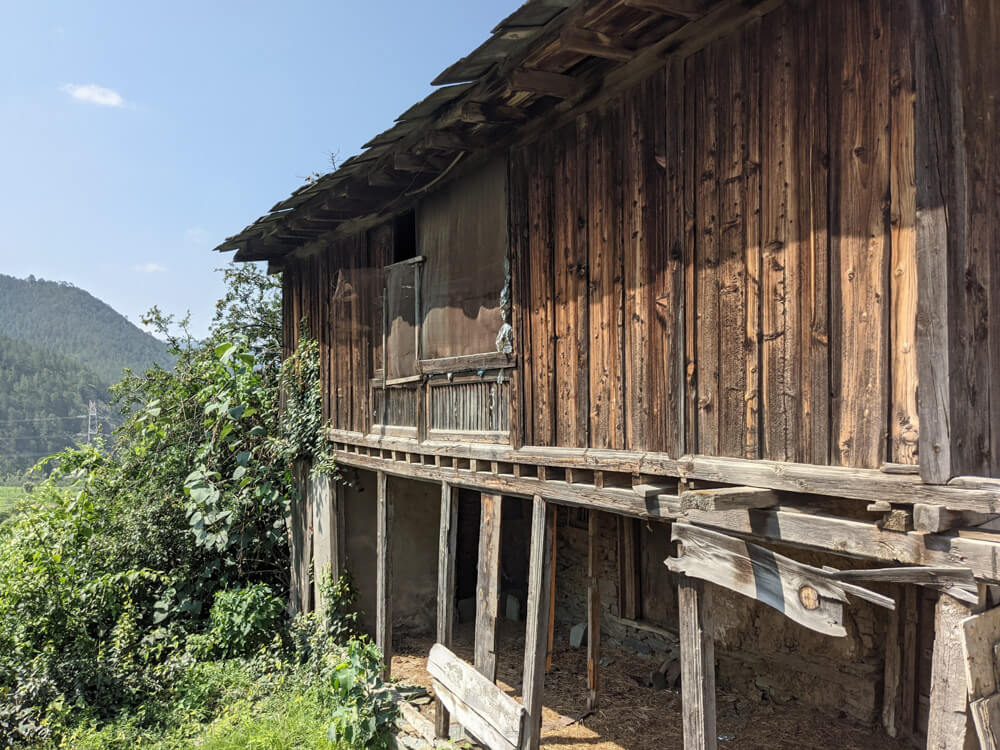
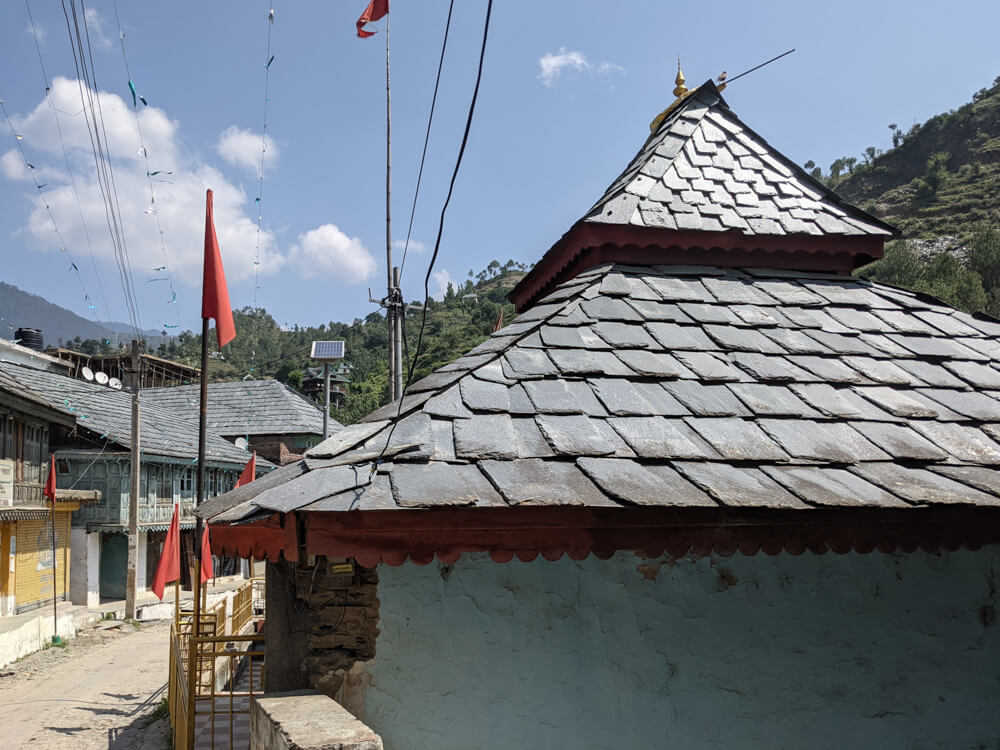
Tired from the journey and the effort in shifting our temporary accommodation, we climbed to our guesthouse. Now we were seated on the edge of the grassy lawn that shone in the faded yellow light. Behind the lawn, the fort stood tall. And next to it was our guesthouse consisting of two rooms—one normal and one VIP.
Three mynas were seated on a tree jutting outside the ground. Due to the uneven feathers and light-colored head, I identified one of them as the lucky child of the other two. They both fed the young hungry one and shrieked if they spotted an eagle above or even a sparrow came to sit adjacent to their family.
We spotted and photographed many different birds around us in the lawn and the apricot tree adjacent to it. A monitor lizard also put up a show by first appearing from nowhere, getting scared at our sight, and then making a proud scamper into the jungle.
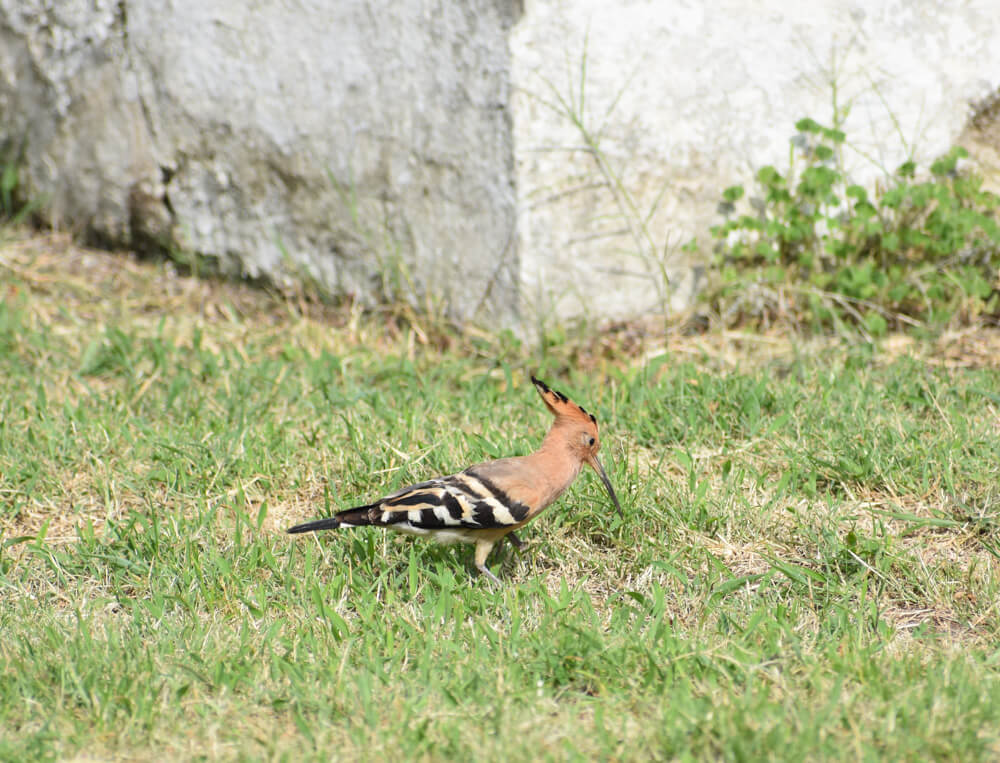
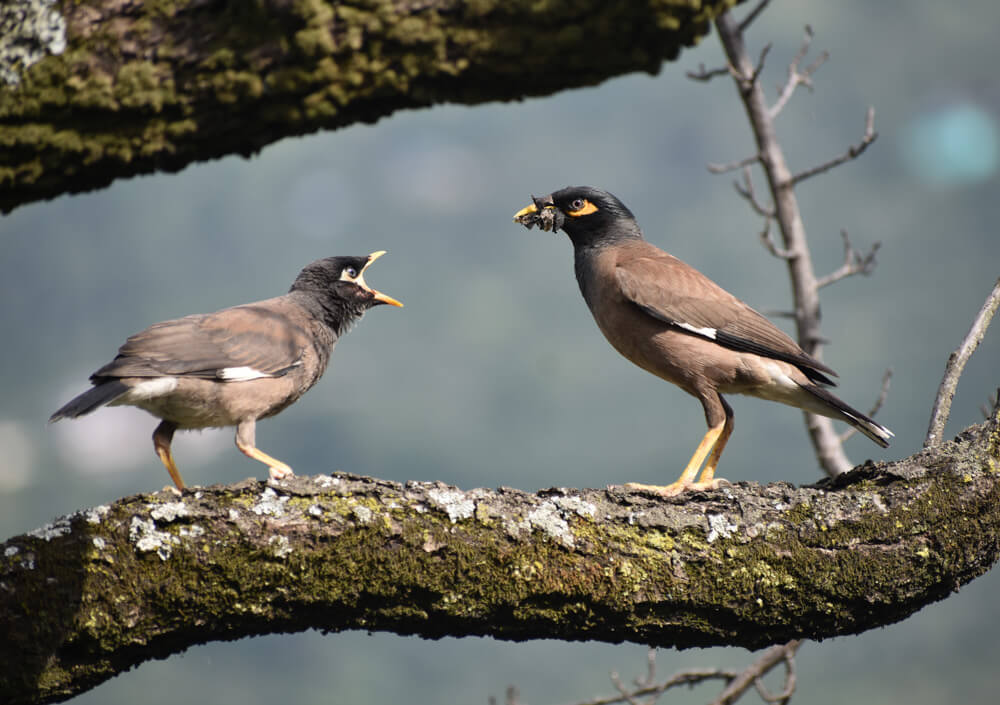
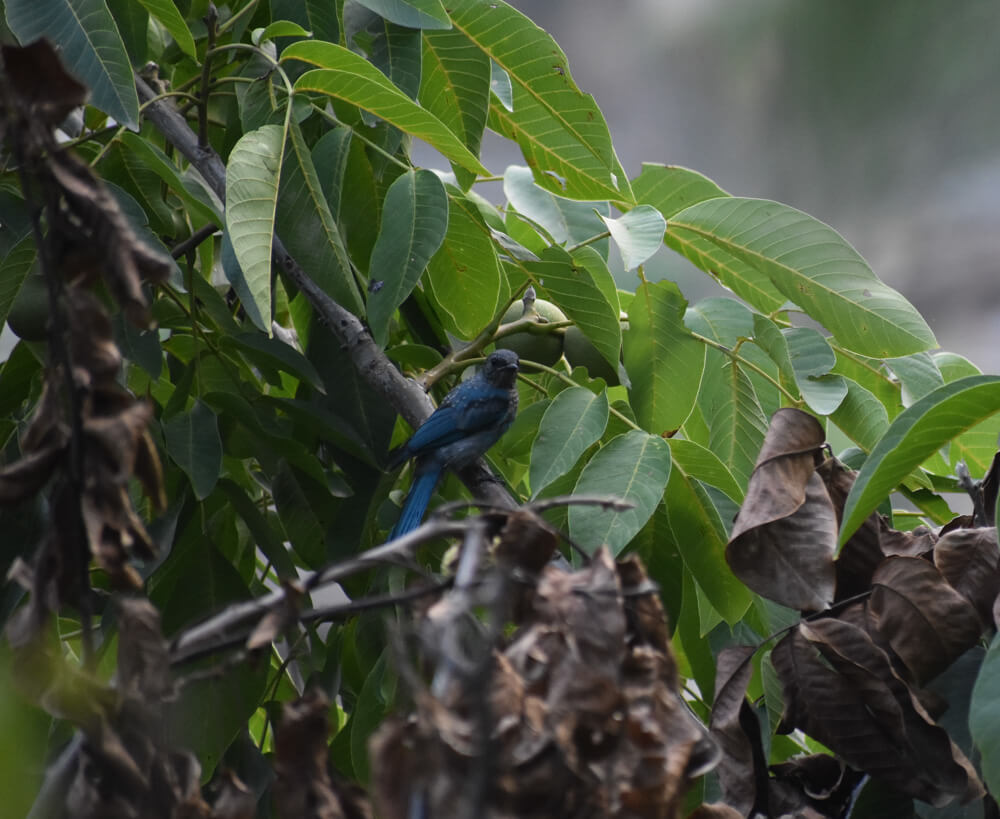
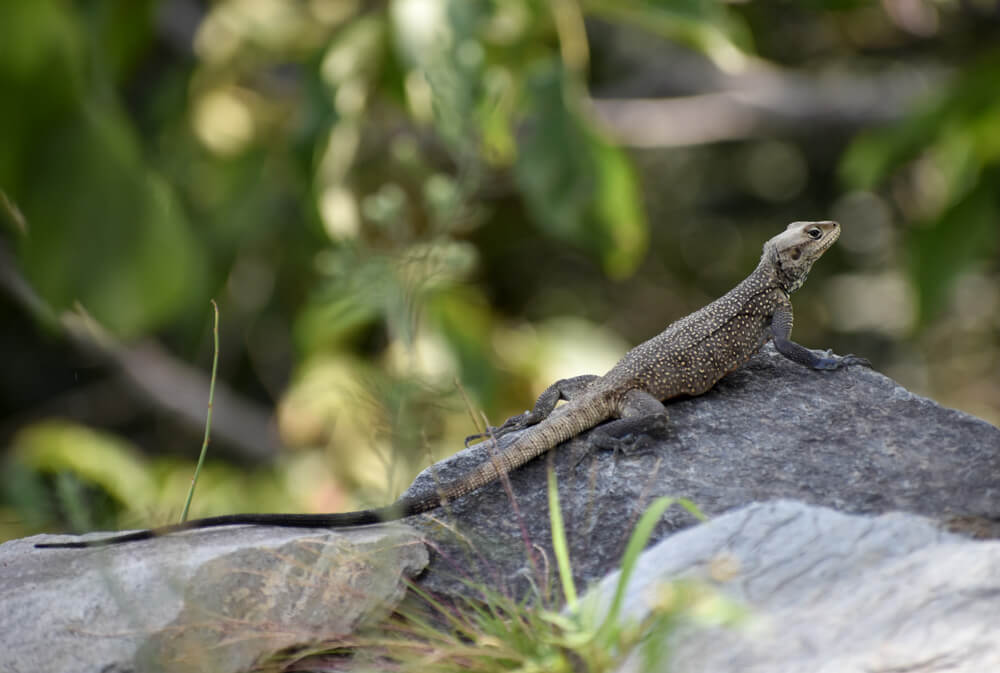
As I sat on the lawn, I caught the glimpse of the tail of a fury animal running into the pipe under the lawn. A few minutes later a mongoose appeared on the other end of the grass. It trotted towards our car and then ran at full speed. Jumping in vain after another monitor lizard who stuck to the building wall, the mongoose went behind the guesthouse and disappeared.
One doesn’t have to go to the jungle if one can visit the Pangna PWD guest house. Enough animals will keep appearing there to amuse any depressed soul.
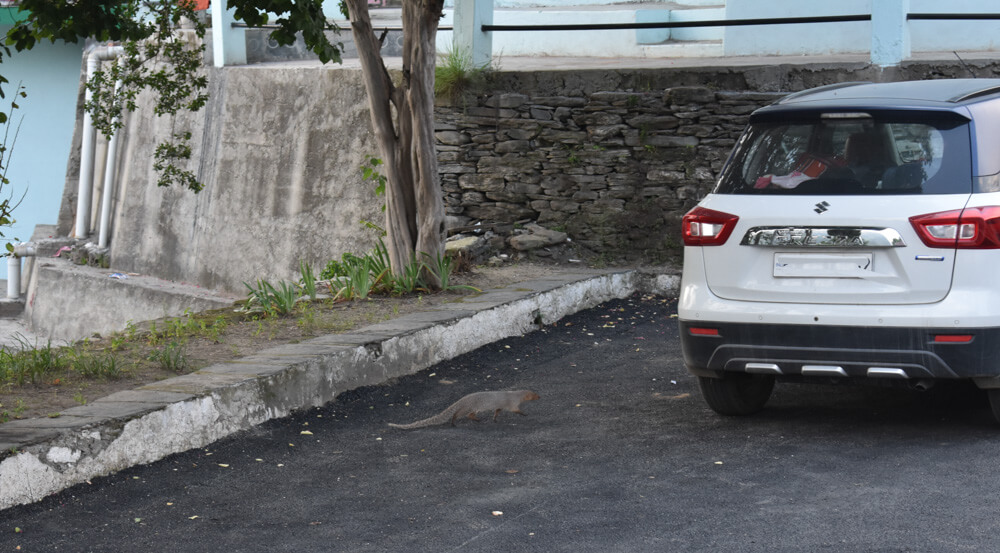
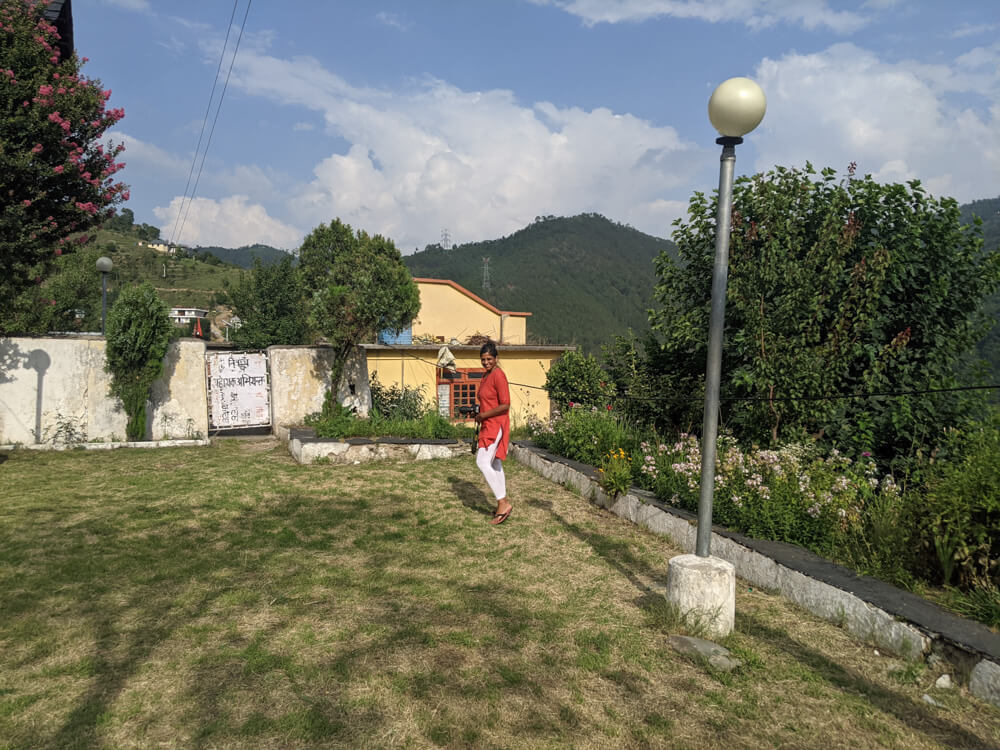
The sun had gone down quite a bit by now. We couldn’t see it, but its orange light had made the clouds shine. We were famished and in preparation for our dinner, brought a table and chairs outside. For the mosquitoes, the caretaker burned two dhoop and two incense sticks. Two glasses of soda and Black Label brought much respite. Even though we had asked the caretaker to serve us at seven, he got the salad plate out at 7:45. And then followed the dal, rice, roti, water, and pumpkin preparation. Later we would come to know pumpkin is a favorite of Mandi people.
We were served both rice and chapati. But I read in the survey that Pangna villagers didn’t eat both rice and chapati together in one meal as it was considered inauspicious. The rule was broken on the death of a relative though. I don’t think this custom was now practiced in Pangna as our caretaker didn’t mention anything about it.
Almost finishing all the curries, we retired to bed early. With windows open and nets in place, our room got a continuous flow of fresh mountain wind. It helped that we were on the top of a hill at the highest point of village Pangna.
I was thankful we had beds. In 1961, Pangna had only 64 charpoys for a village of 585 people. So it was obvious the villagers slept on the floor and kept most of their charpoy for guests. Manjaries, prepared from paddy stalks, were used as mattresses on the floor. In the morning people would roll up the manjaries and keep them on the side of the room before going to do their business near the khud or in the farmlands. The village didn’t have any indoor toilets in 61.
At 5:30 am my alarm rang. I had been waking up early every day in Himachal Pradesh but now the lack of sleep was catching up. Looking at the quaint morning outside where birds chatted in full fervor, I decided to sleep a bit more. The silence the night holds and the bustle the day brings had mixed together to form a calm you can only feel at dawn. Absorbing the waking up stillness, I got up once at 7 to wake up my partner for his meeting and, finally, got out of bed at 8:15 am.
Starting my day with a golden peach and a hot shower, I took the steps behind the guesthouse to descend into the village. Soon I was on a road through the Pangna village. A few old picturesque shops were located on both sides of this road. I can’t seem to find the photos of those shops, but on some of them, names and businesses were painted in an old systematic font and style. Much like in the city of Jaipur and Jodhpur.
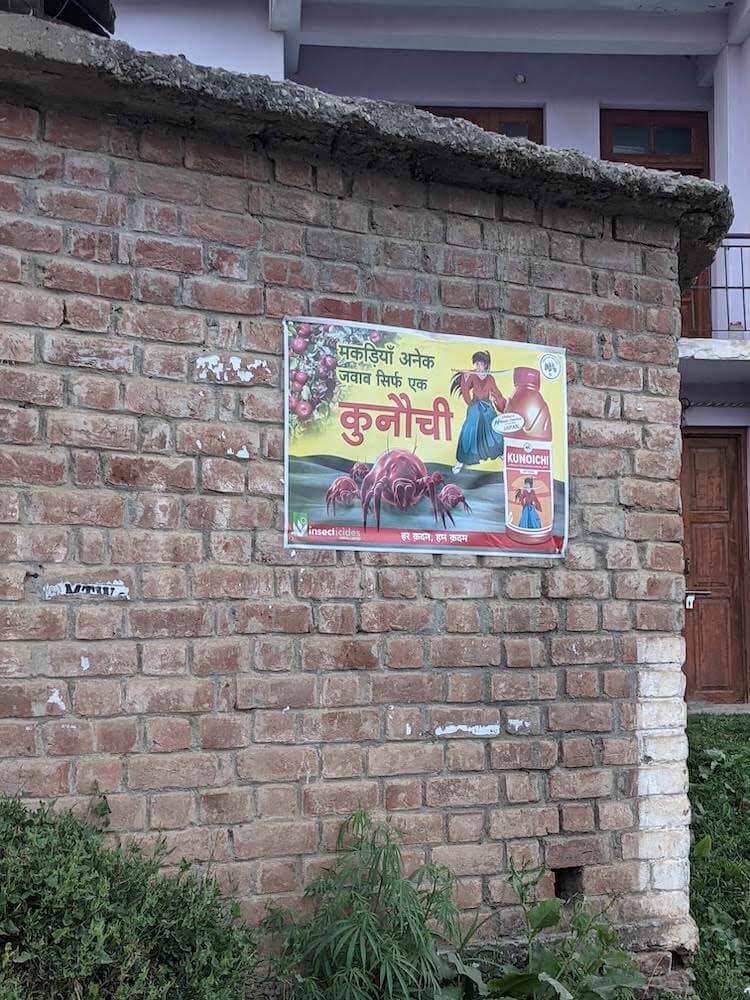
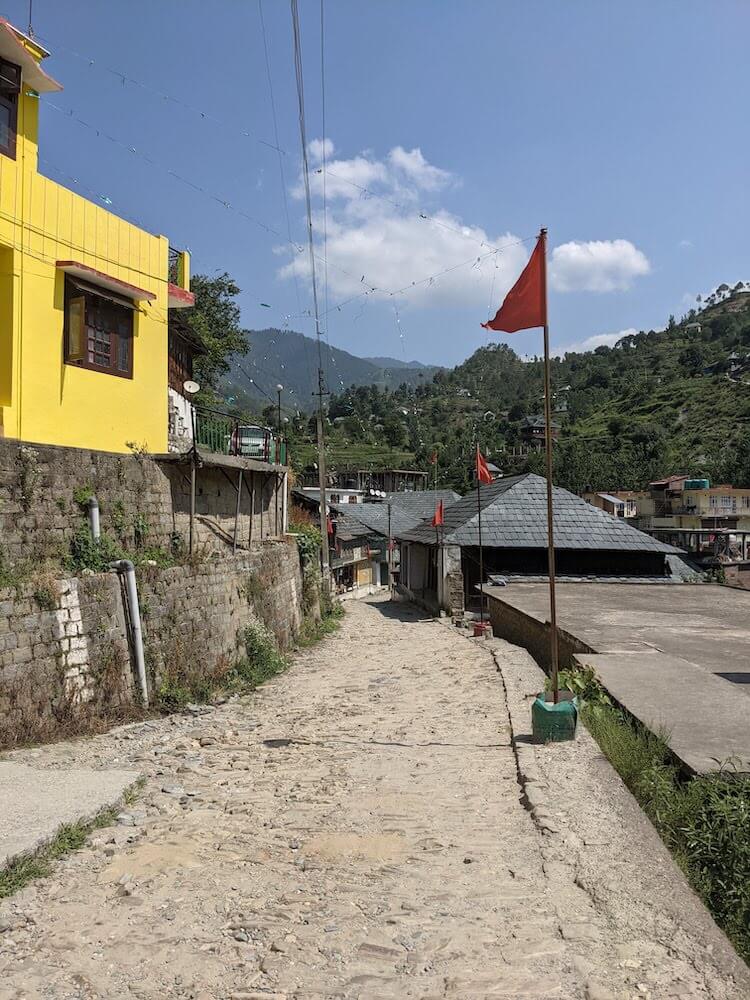
Further, I crossed the bridge onto the brook, the khud of the Pangna village. Crossing ahead, I found more shops and sweetmeat places. Everything seemed so dusty for there hasn’t been any rain. I turned around and instead of taking the path I had come down on, I took the road going next to the nullah into the village. On the way, I crossed the path fringed with red flags that would go to the temple. All of the surrounding lands belong to the temples.
The stories about the temples, their Mahatmas, and the priests are interesting and can be read in the census document.
Farmland covered some areas near the nullah. There was a big hoarding put up celebrating the 150th Mahatma Gandhi Jayanti. So the population of Pangna rose from 585 in 1961 to 1154 in 2011 to 3354 in 2019. Old and new style houses with a melancholic look to them stood on both sides. I crossed the Pangna health care center too on which people formed a long queue to get the vaccine. The Fort could be seen even from that low point of the village.
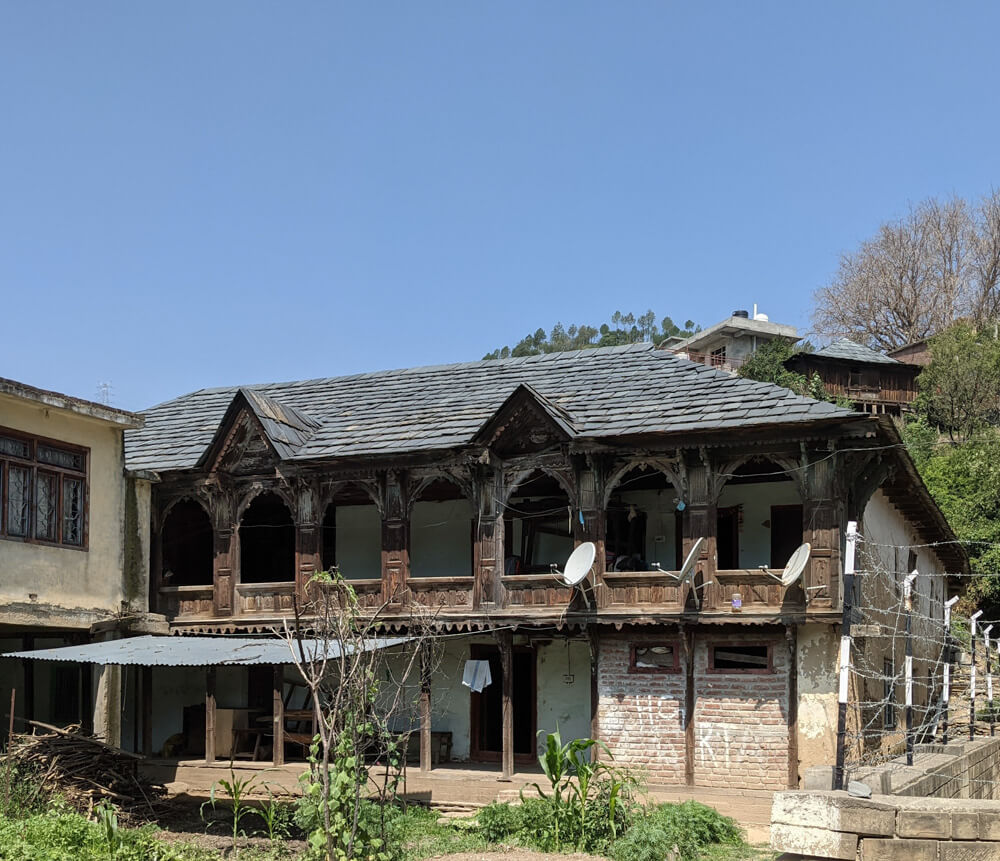
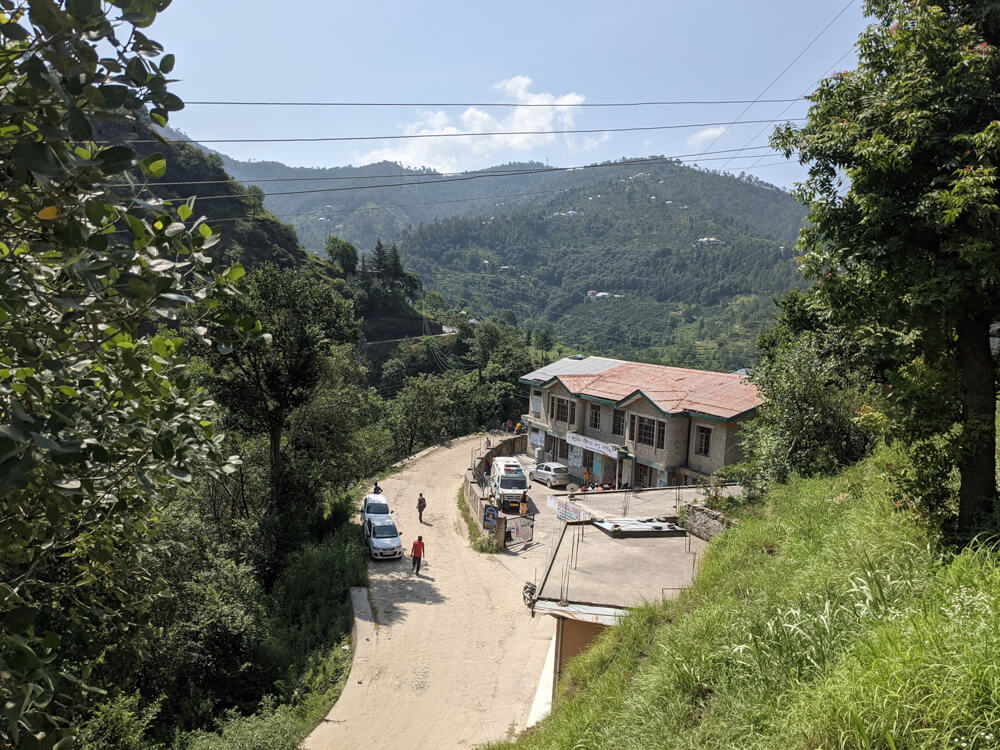
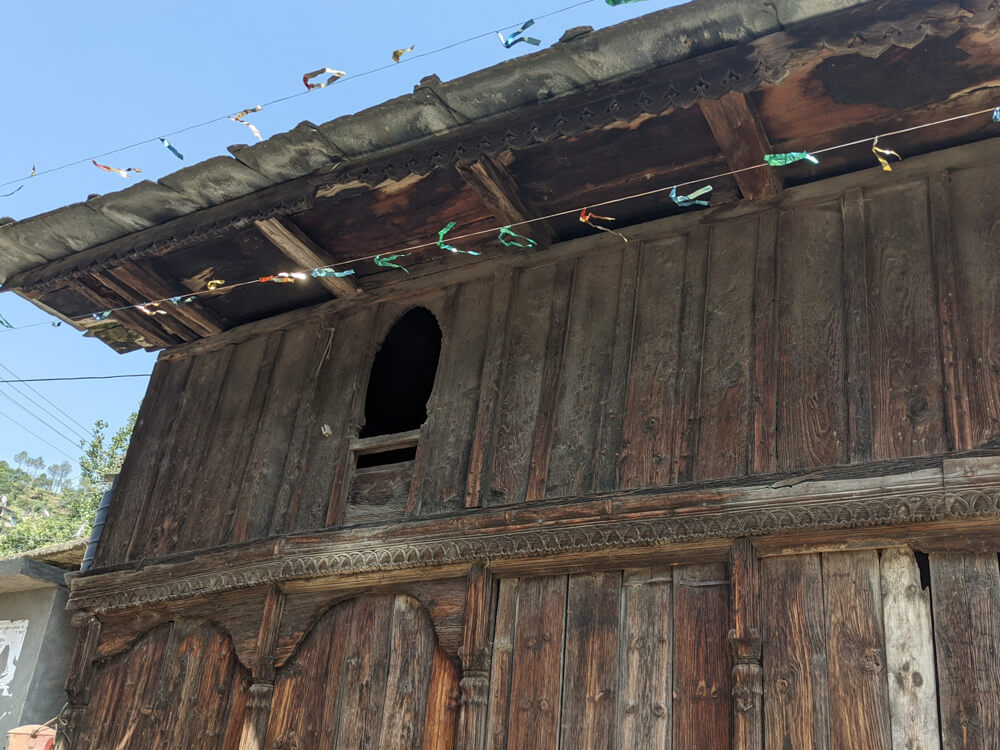
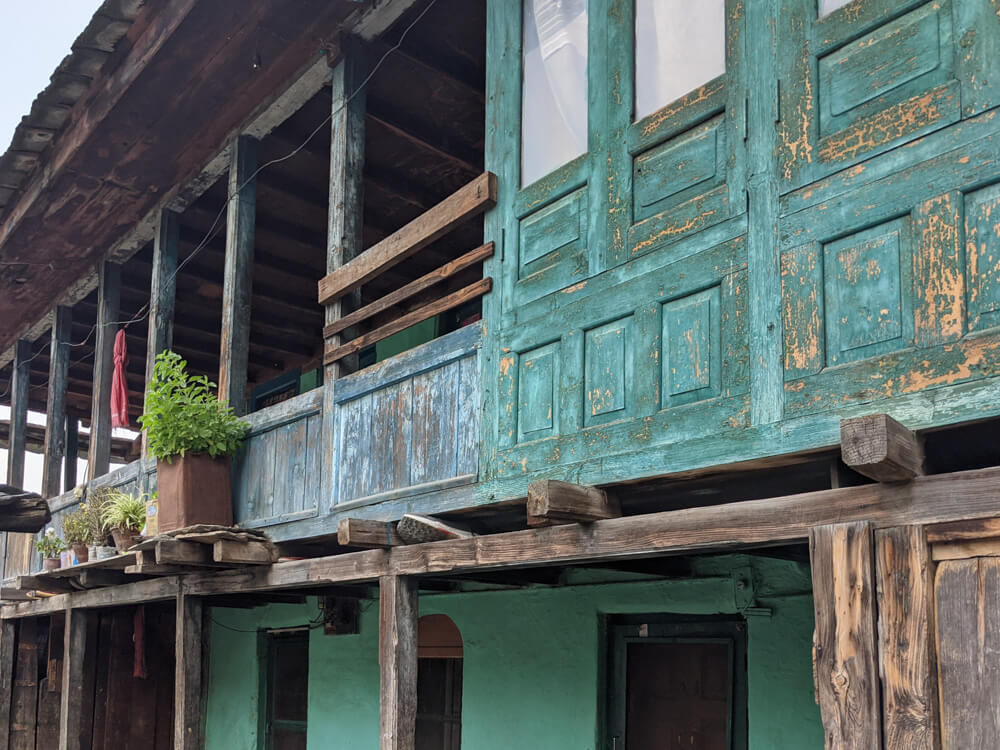
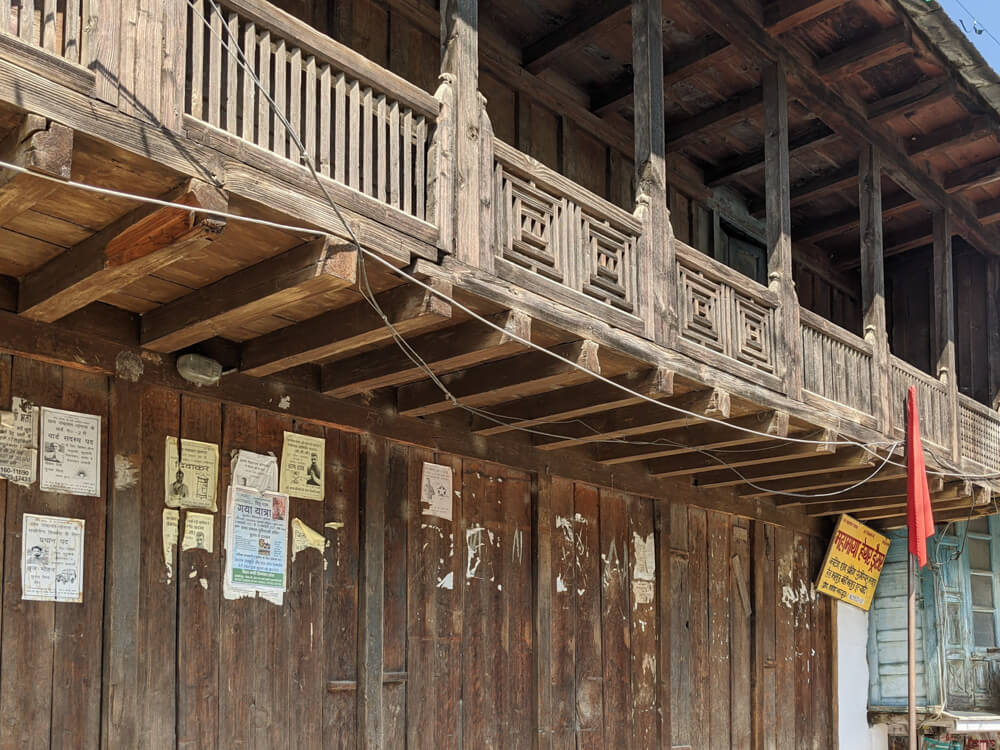
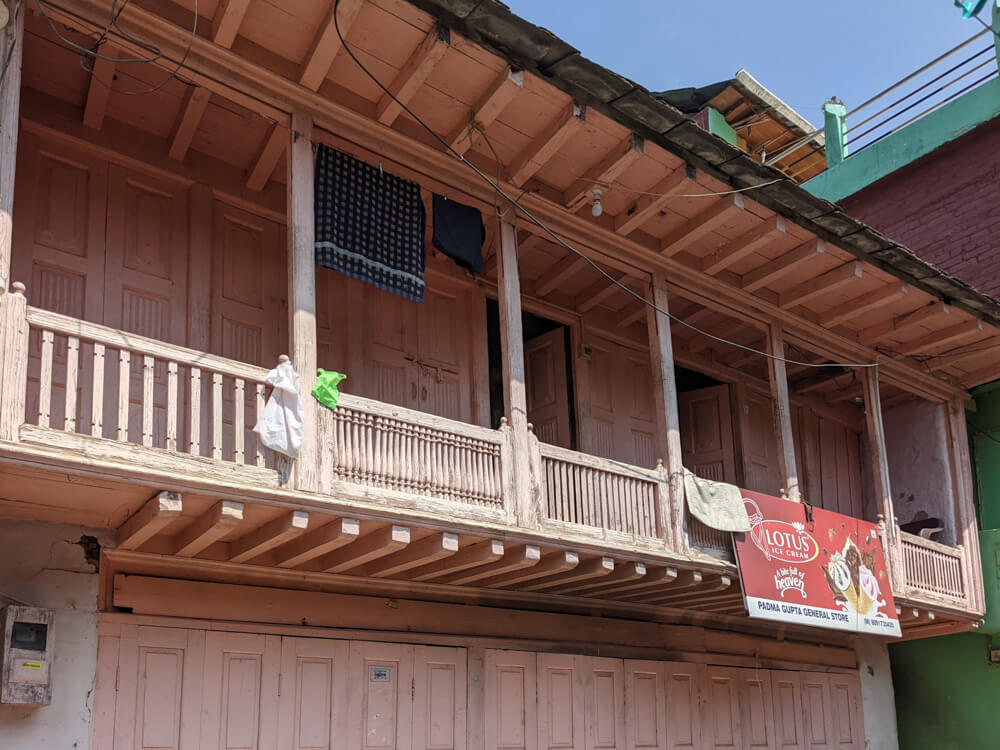
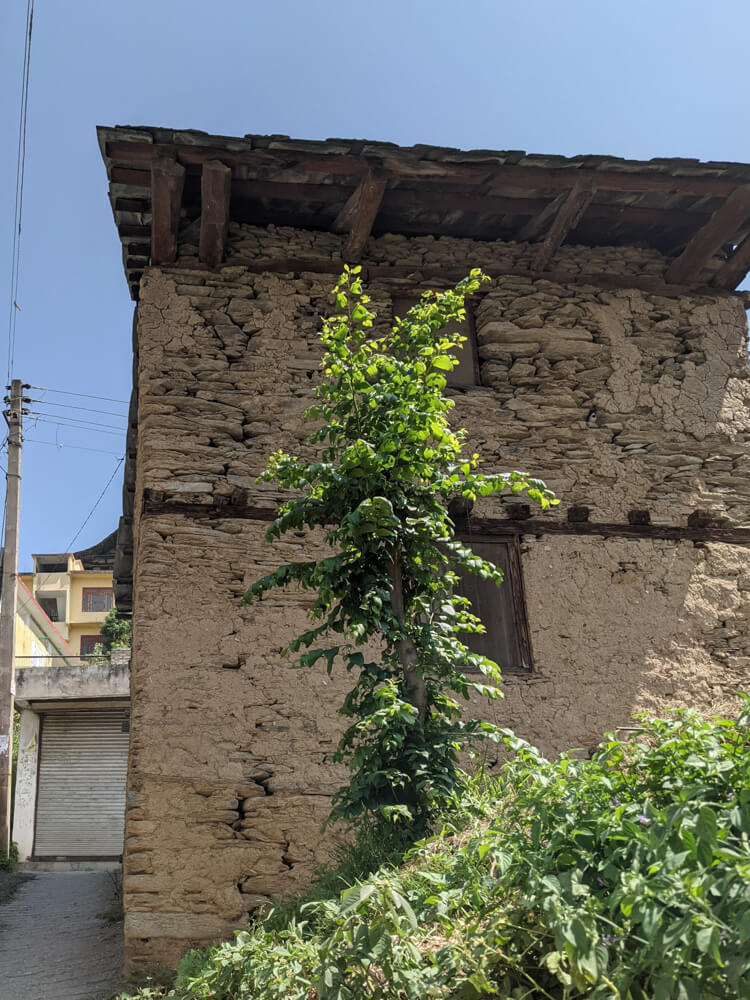
A note on Pangna houses: As per the census report, “Walls were built, 1.5 to 2 feet in thickness, in dry stone masonry, with beams of wood at regular intervals. The wooden beams serve as binders otherwise the entire wall is likely to crumble down under its own weight. Doors in the old houses are about 5 feet in height and about three feet in width. No proper windows were provided in these houses. Small recesses called teeras, were provided inside in the walls in every room, for keeping lamps or other small articles there. Comparatively in new houses or’ old houses repaired, which are few, six feet high doors and proper windows in all the rooms, have been provided.”
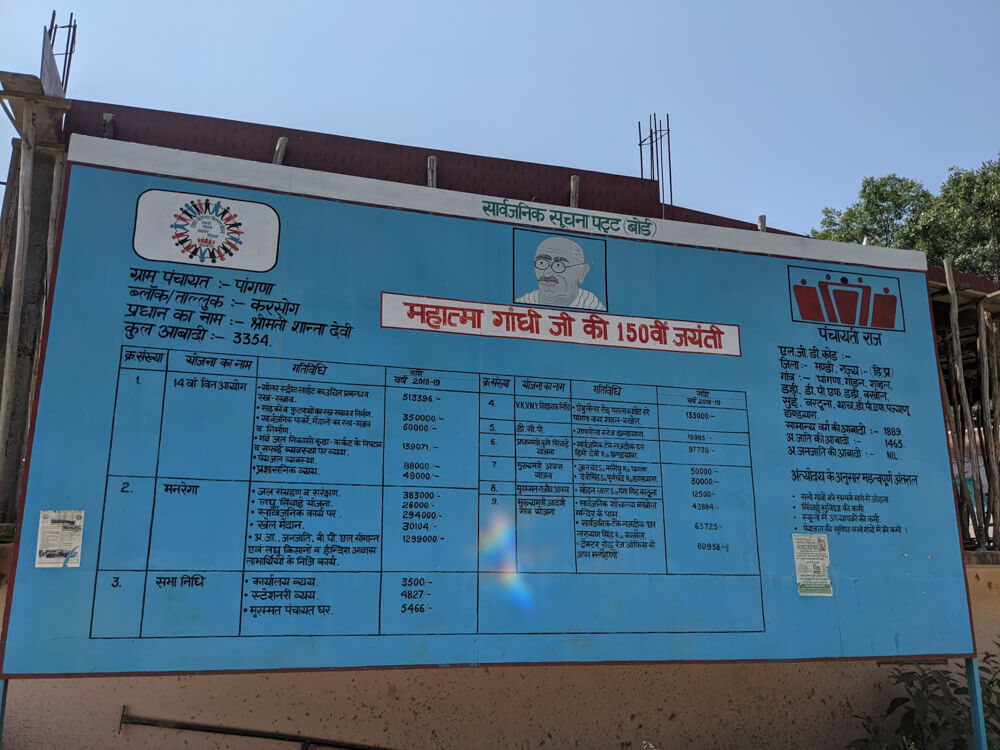
Some villagers (probably on their way to the health center) looked at me curiously. I asked a woman herding her cows the way back to the Fort. She told me I just had to walk up the path next to me to arrive near the temple. As I trudged up in the strong sun of the afternoon, I saw the blue shiva mandir at the end of the cemented lane. I got up the stairs to sit under the pipal tree and took out my diary.
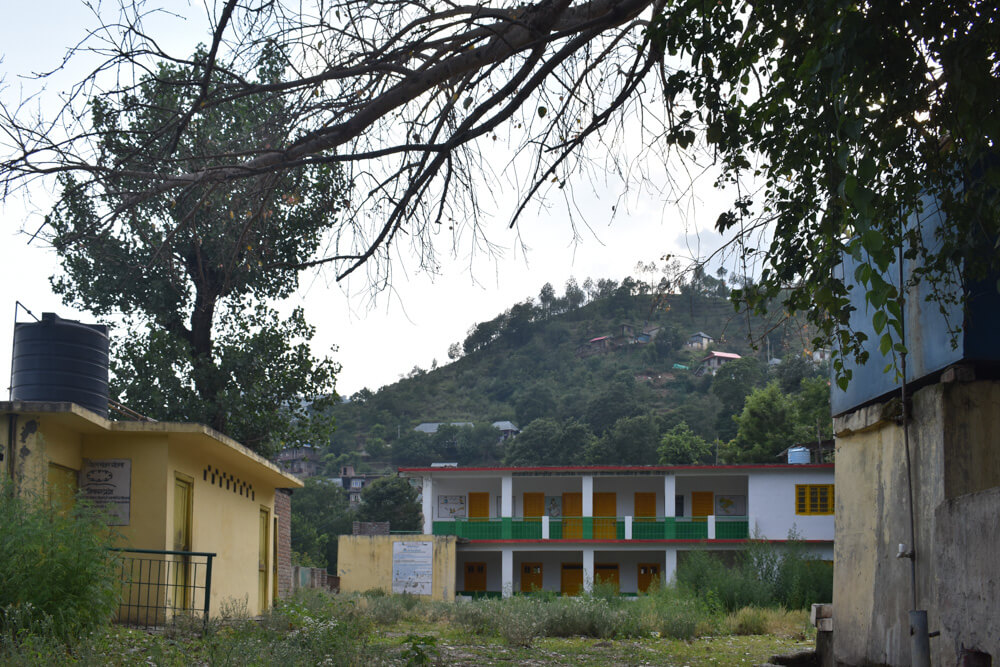
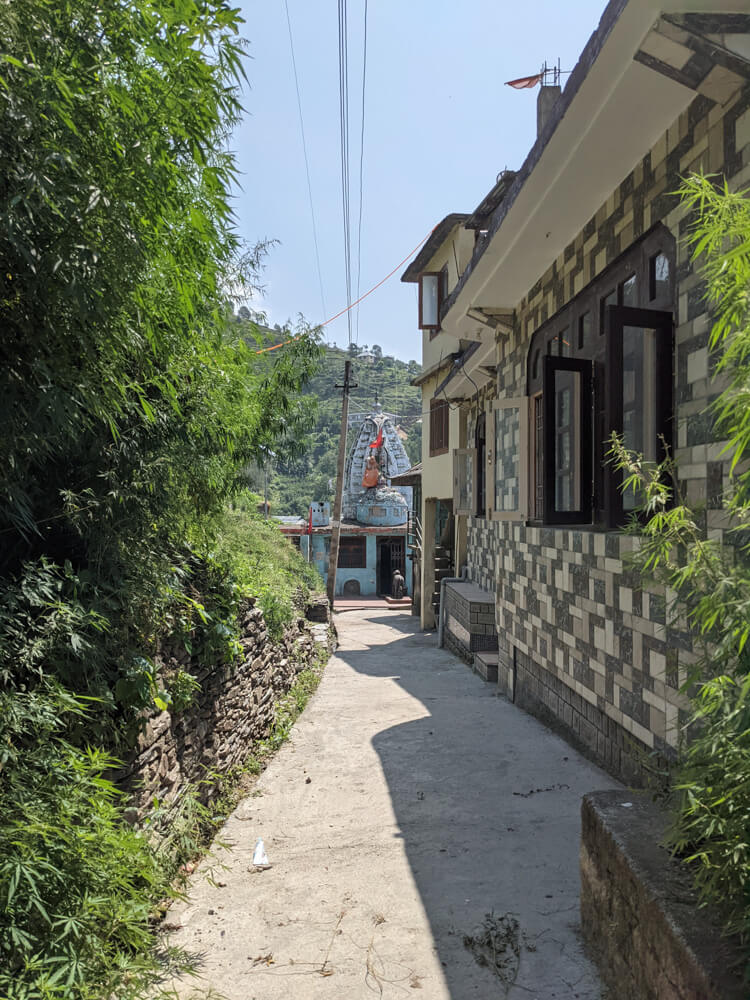
Most of these notes you have read now are written during those hours when in the shade of the Pipal, I watched the villagers doing their daily chores and admired the abandoned yellow school building behind the pipal tree. If I had such gorgeous scenery from my school and lots of pomegranate trees to pluck from, I would have never studied a word. My helplessness wouldn’t be much different from now, when seated in this misty home of Karsog Valley, I watch the villagers herd their sheep into the jungle. But soon I can see neither the white and black fury beings nor their kurta-clad old male owner. Clouds float into my room and onto my computer and all I can feel is a chill and an urge to go beyond.
Soon!
Where is Pangna?
Pangna is a small village in the Karsog municipality (tehsil) of district Mandi in Himachal Pradesh. The village lies 10 KM from Karsog, and 37 KM from Shimla.
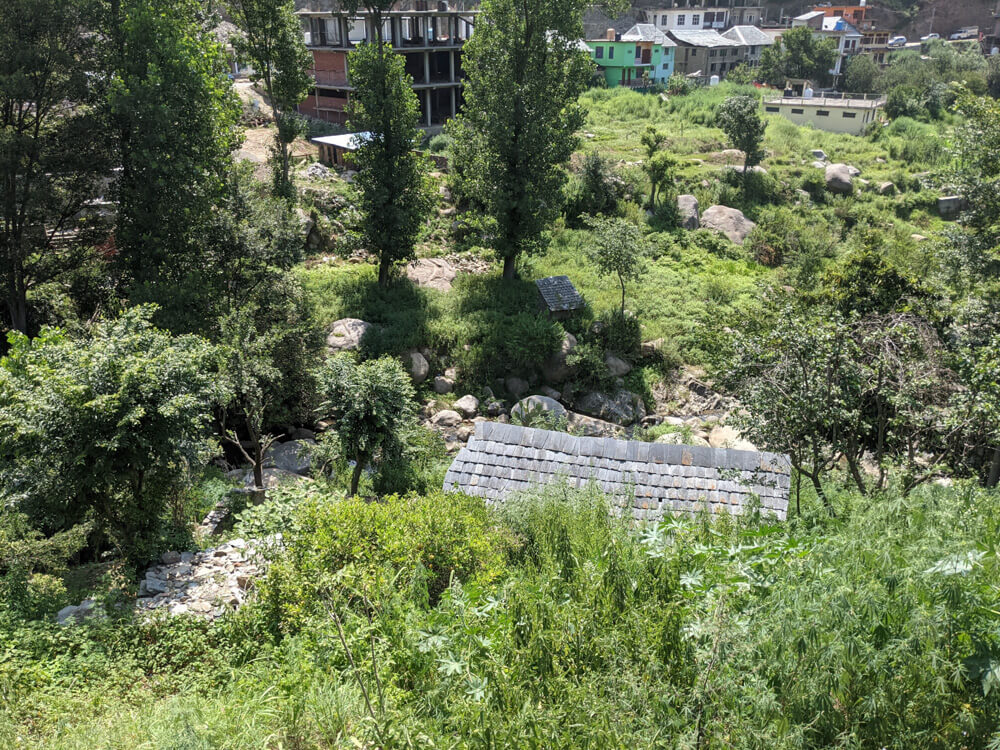
Where to stay in Pangna?
Call here to book a stay in Pangna Himachal Pradesh Public Works Department (HPPWD) guesthouse (this is the one in which I stayed). I will soon publish a guide on HPPWD guesthouses and so that can be refered for more information.
Other hotels to stay in Pangna are Suket Homestay (right in the village), Thandapani Spring Guest House (7 km from Pangna) and Koyla Hotel and Restaurant Mandi (4 km from Pangna). I can’t find the Booking link to any of these so please do some internet research and call and book.
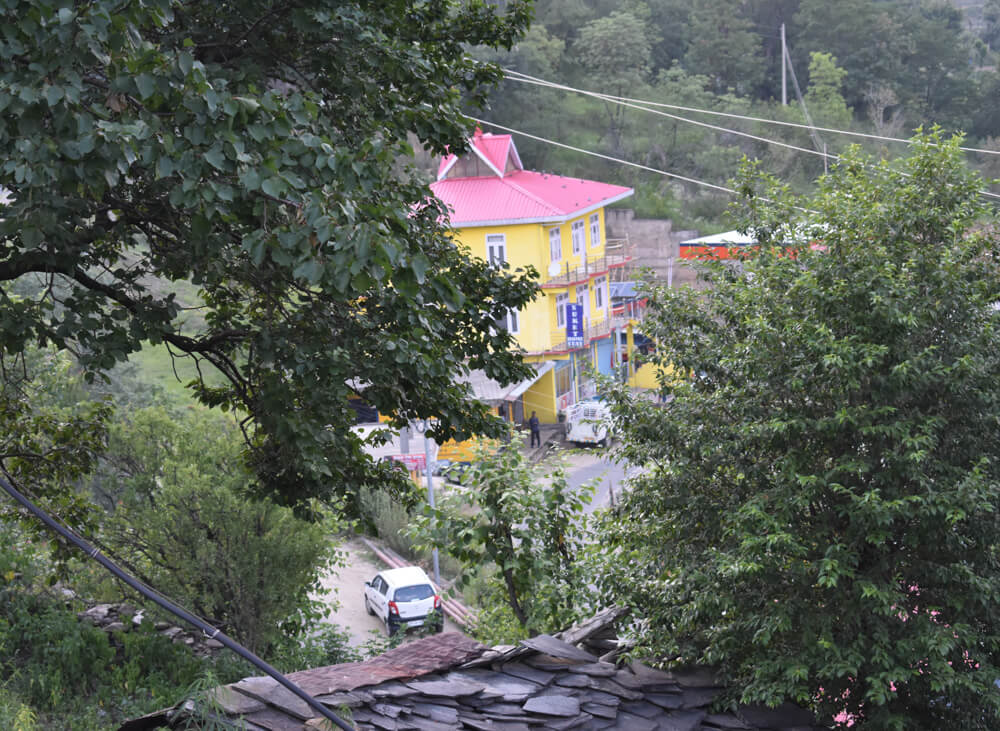
Follow up read: Visiting the Mahun Nag temple from Nalagali village in Mandi (Coming up soon)
The Mahun nag temple where Pangna villagers used to go in large numbers for a fair every year. It is said that Mahun Nag is another name for Karn of Mahabharata and when the ruler of Suket was once held captive at Delhi, he invoked the blessings of all the gods of his area to help him out of the jail. It is believed that the Nag Devta took the form of mahun—a bee, and brought the king safely back home. The ruler left quite a big tract of his area for the mahun where the Nag ruled for some hundred years.
Would you love to visit Pangna, Mandi? Tell me in the comments.
*****
My much-awaited travel memoir
Journeys Beyond and Within…
is here!
In my usual self-deprecating, vivid narrative style (that you love so much, ahem), I have put out my most unusual and challenging adventures. Embarrassingly honest, witty, and introspective, the book will entertain you if not also inspire you to travel, rediscover home, and leap over the boundaries.
Grab your copy now!
Ebook, paperback, and hardcase available on Amazon worldwide. Make some ice tea and get reading 🙂
*****
*****
Want similar inspiration and ideas in your inbox? Subscribe to my free weekly newsletter "Looking Inwards"!

